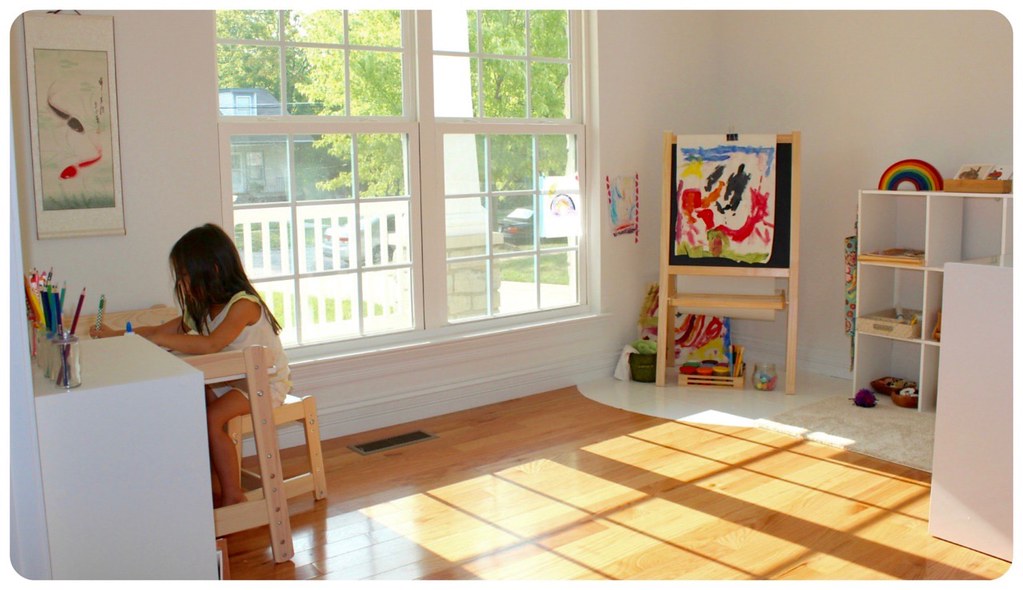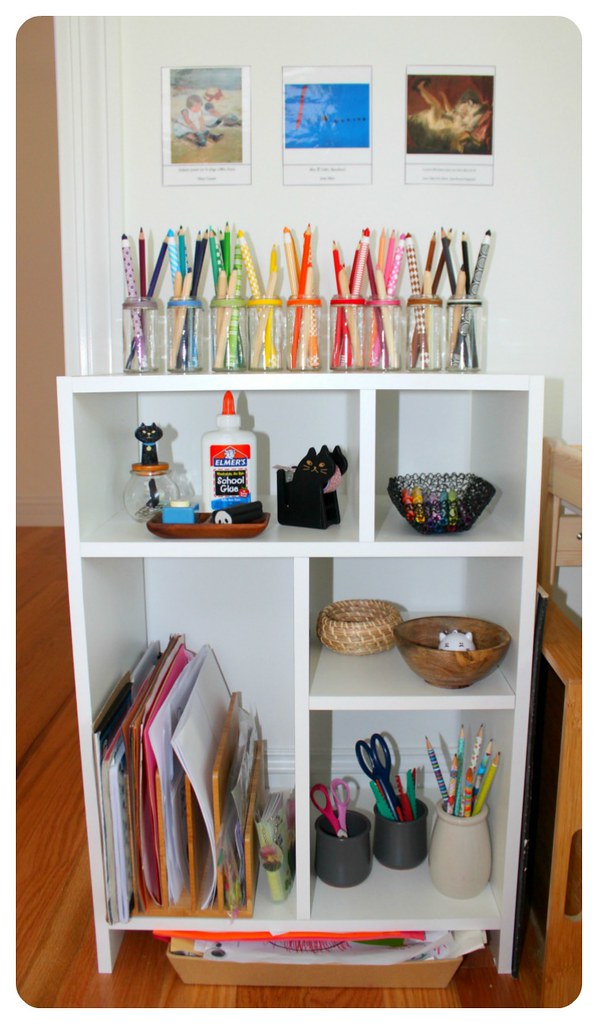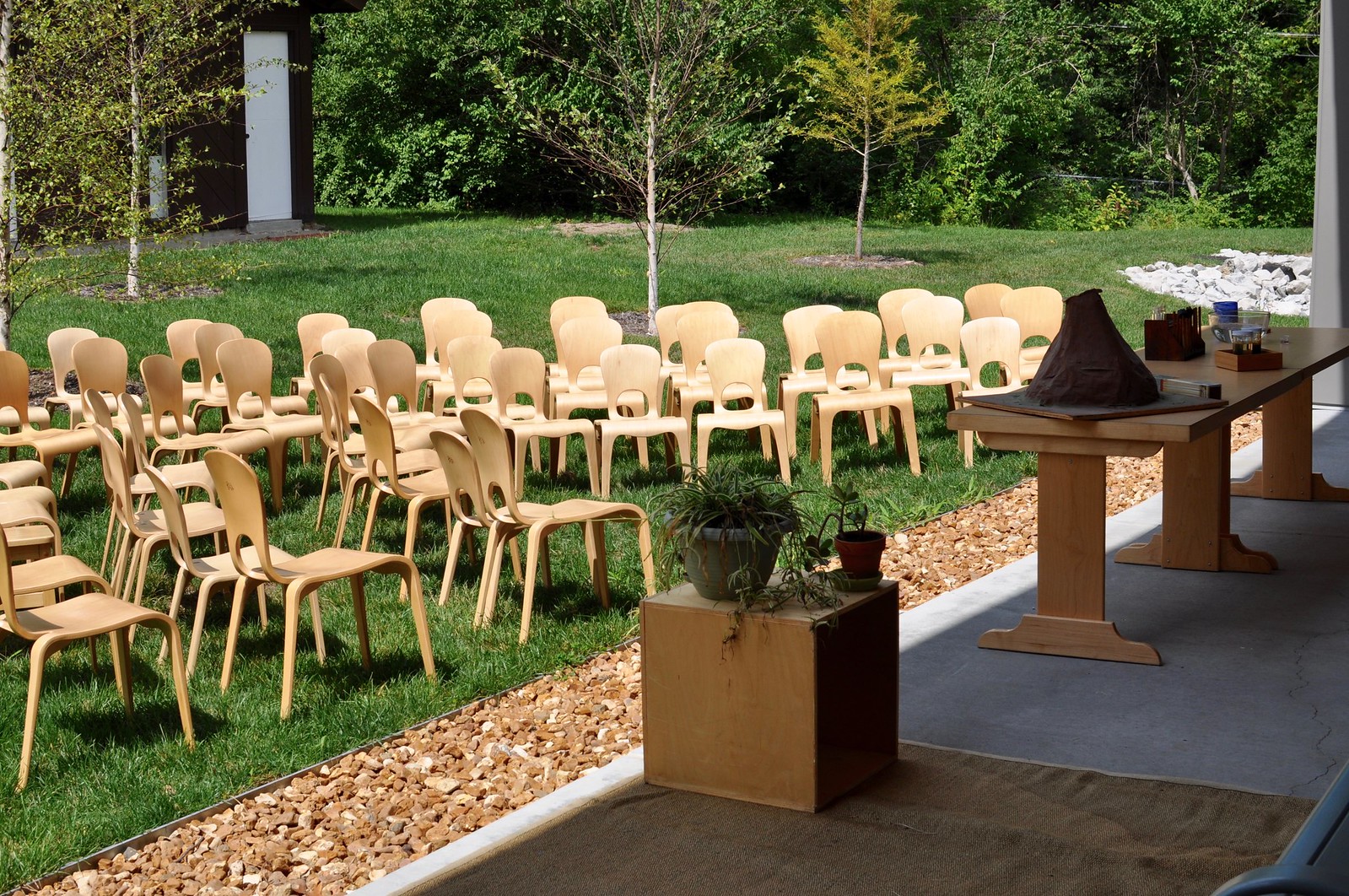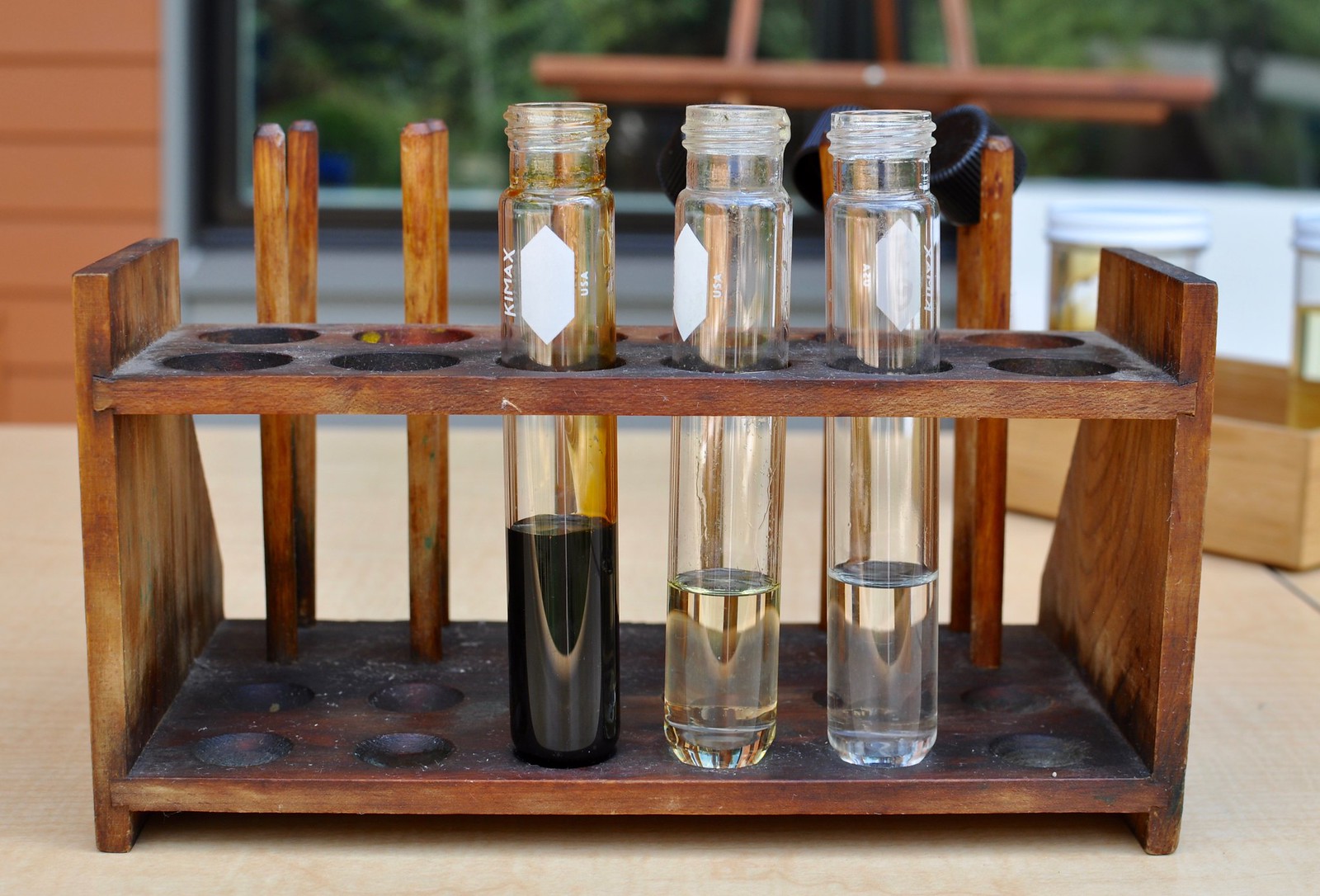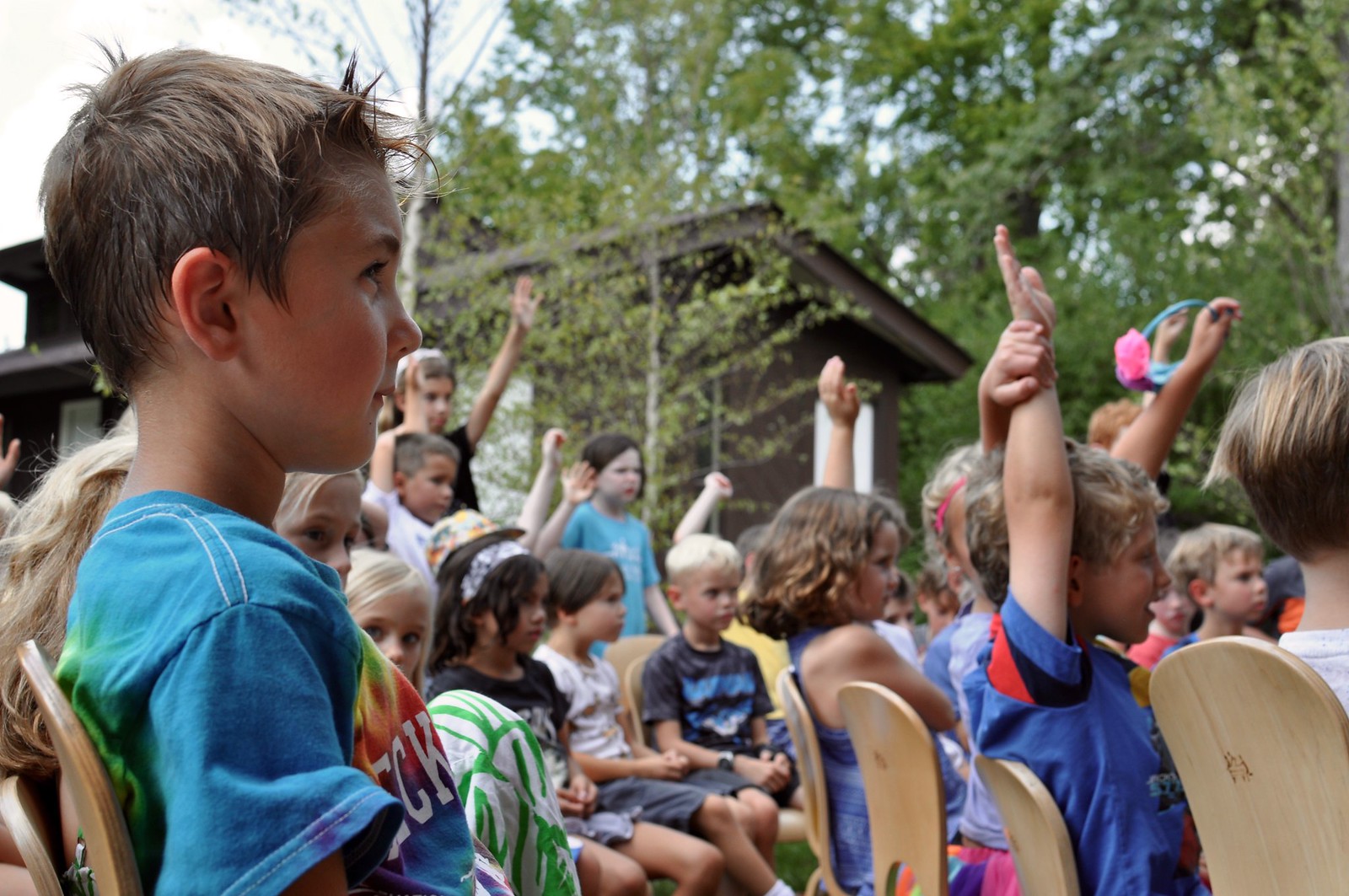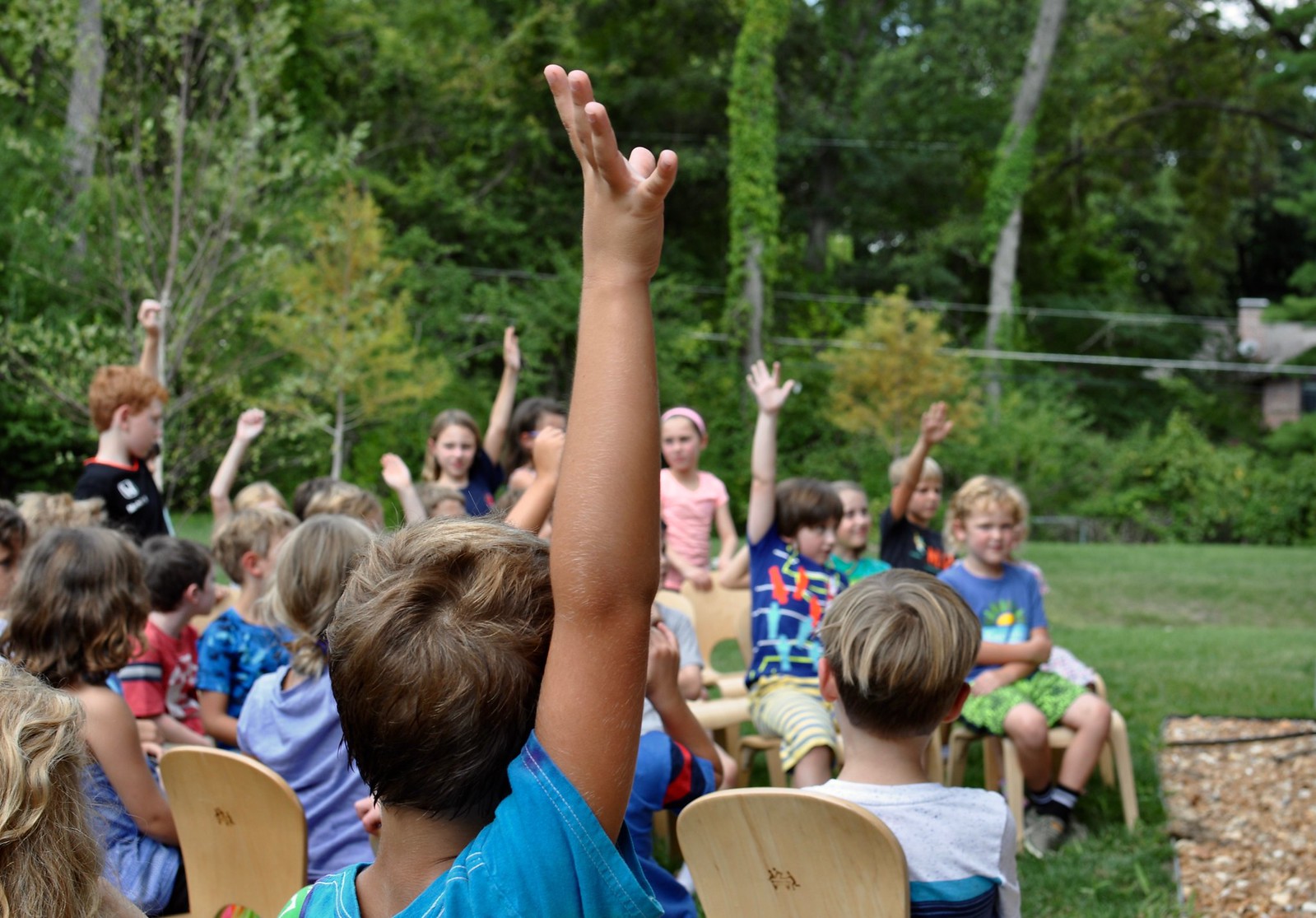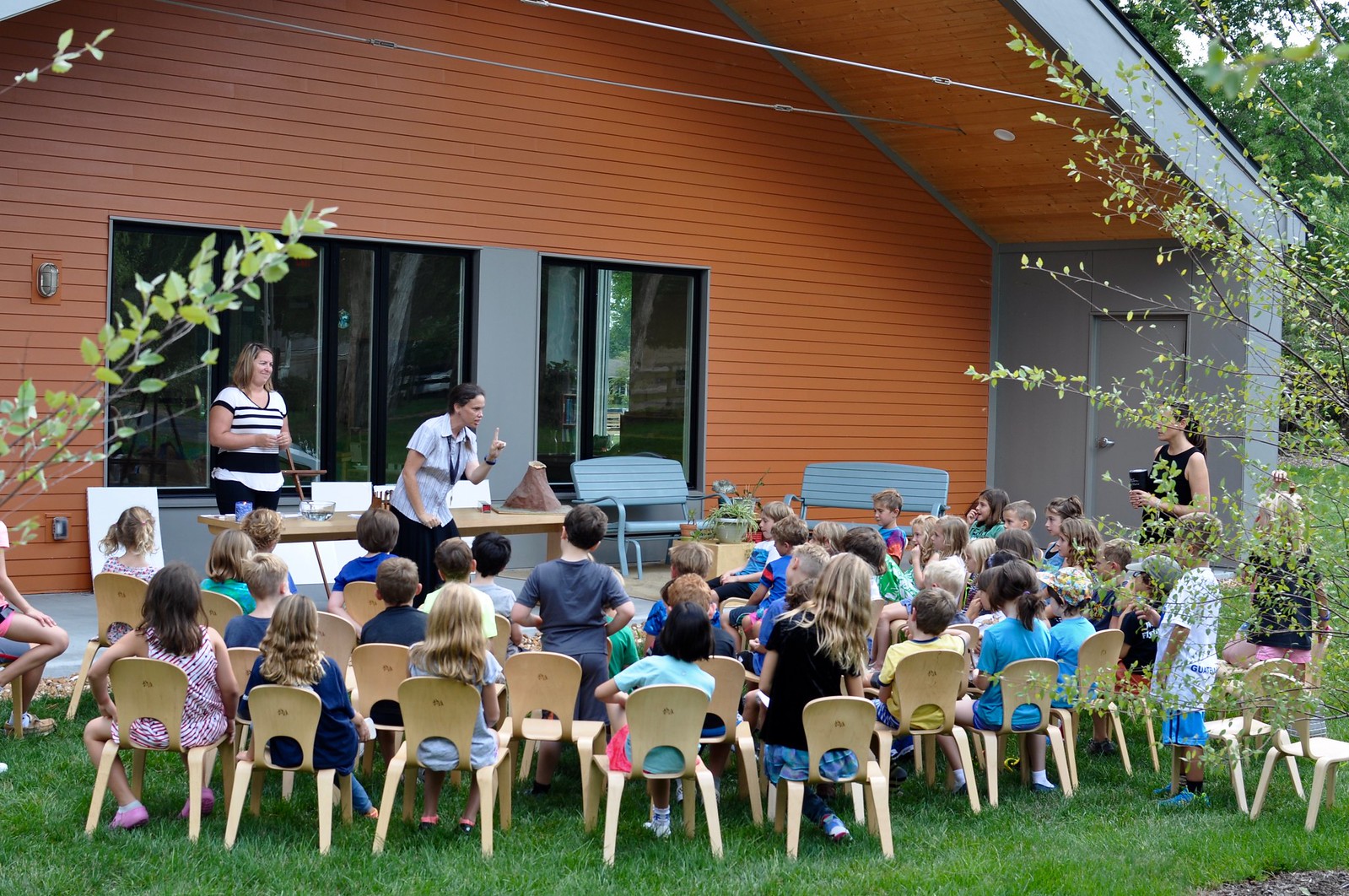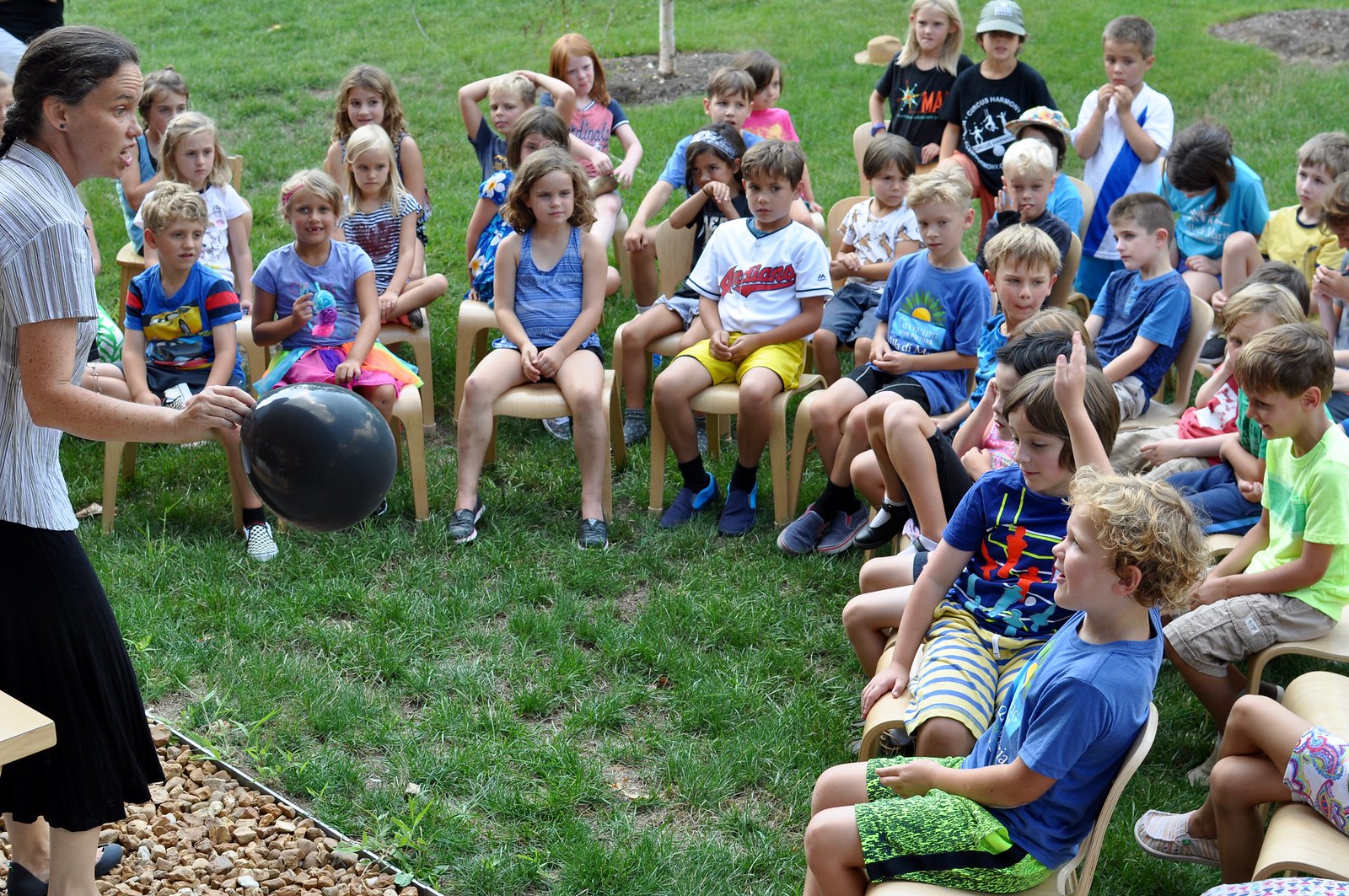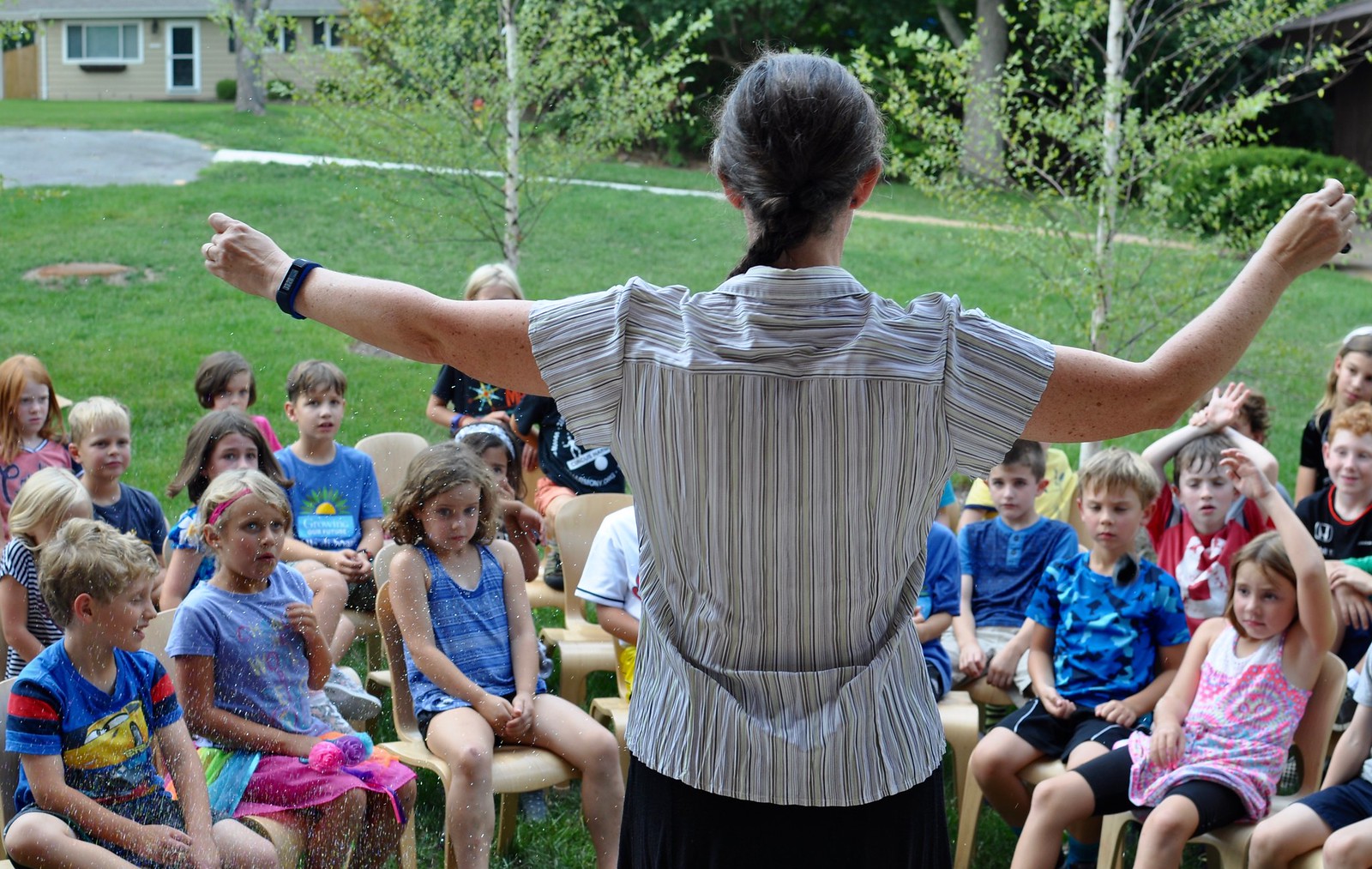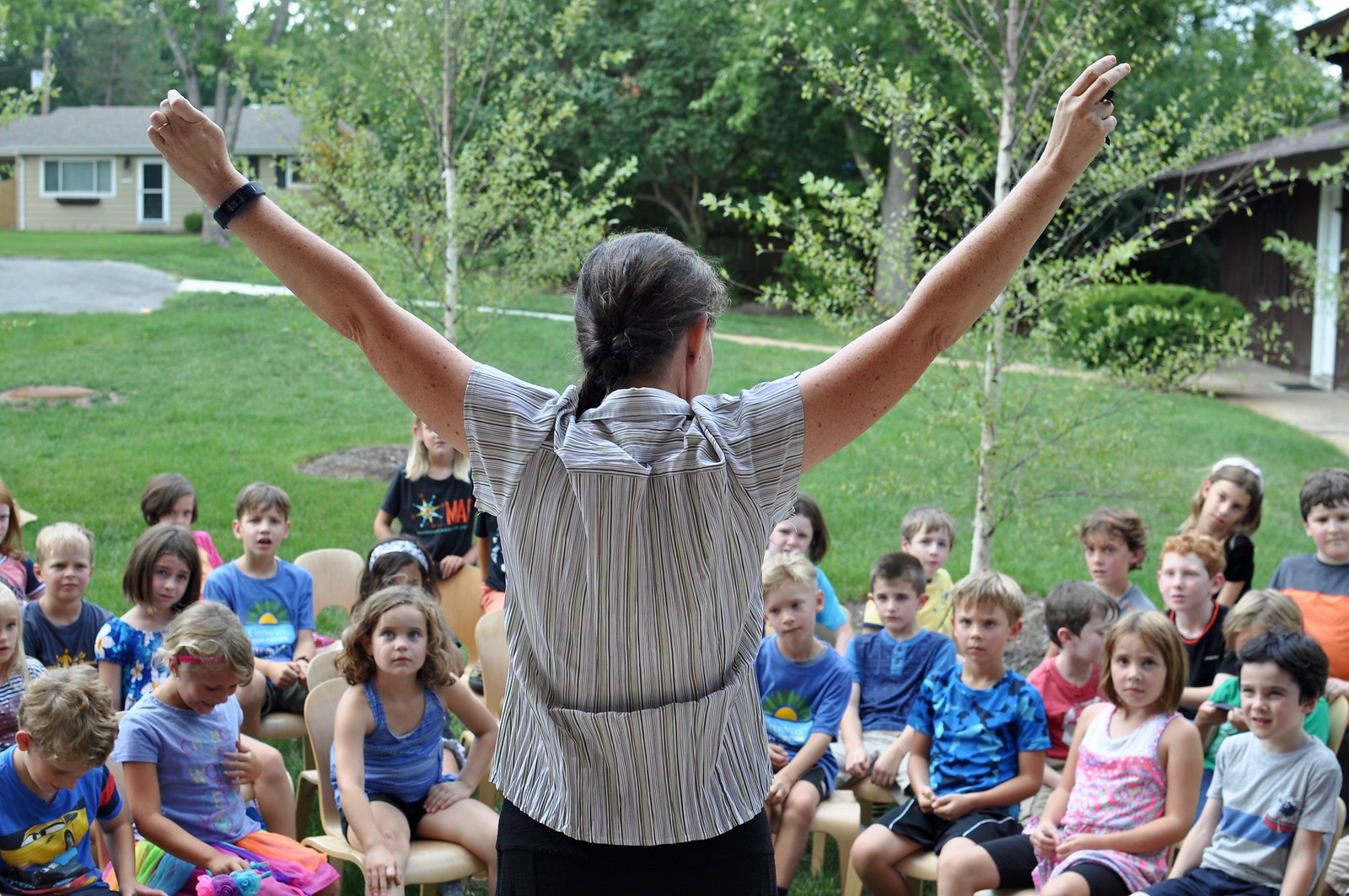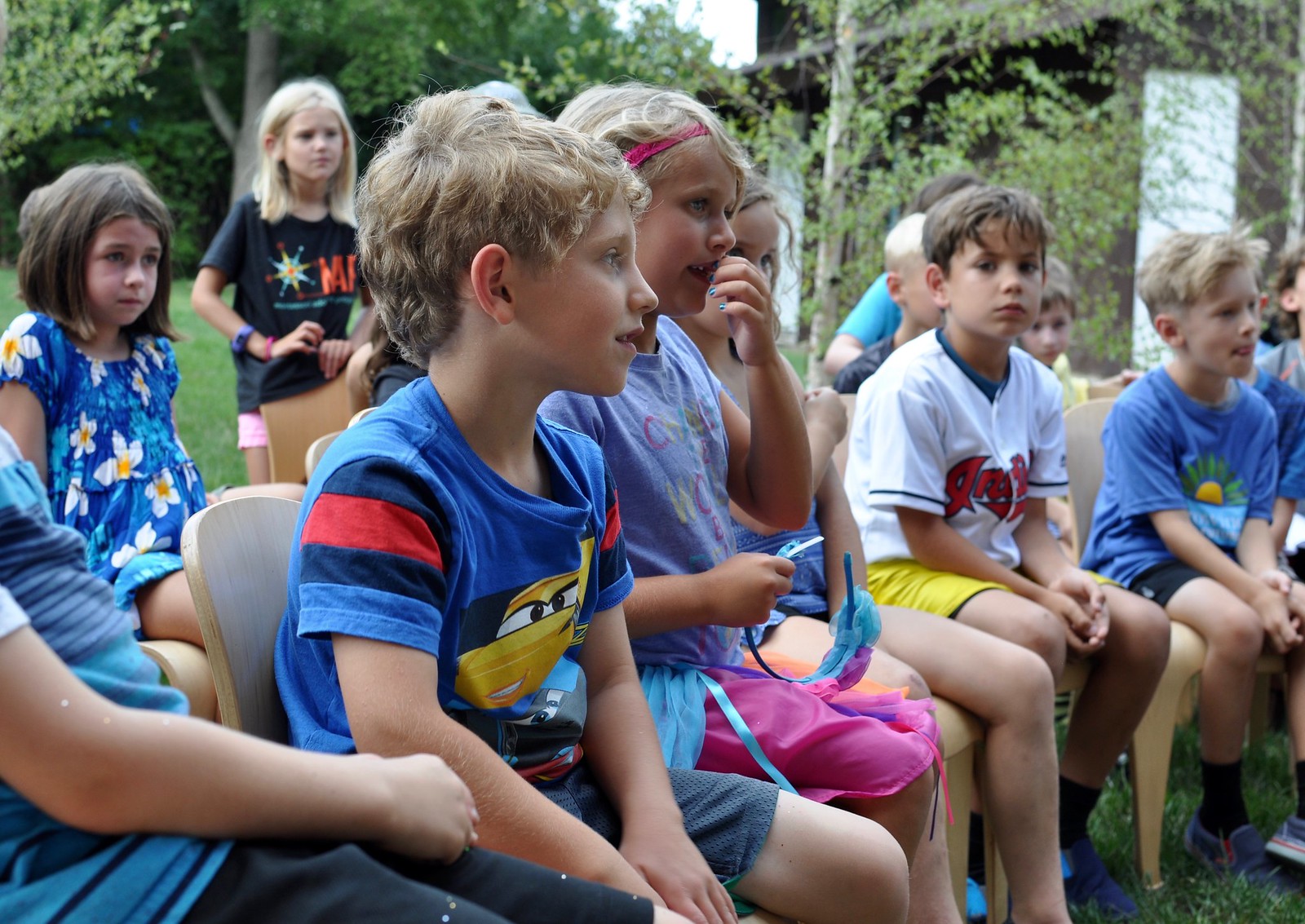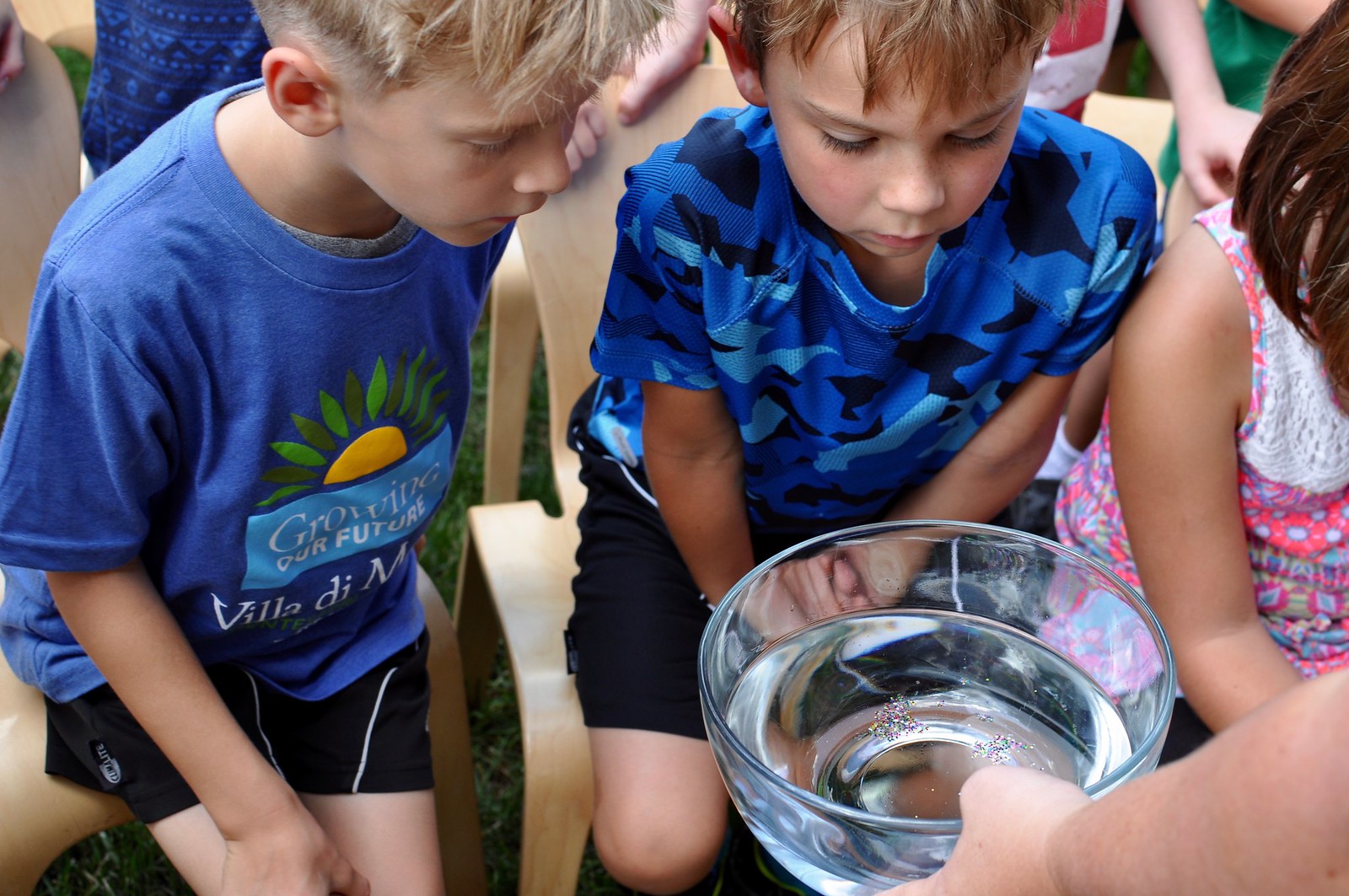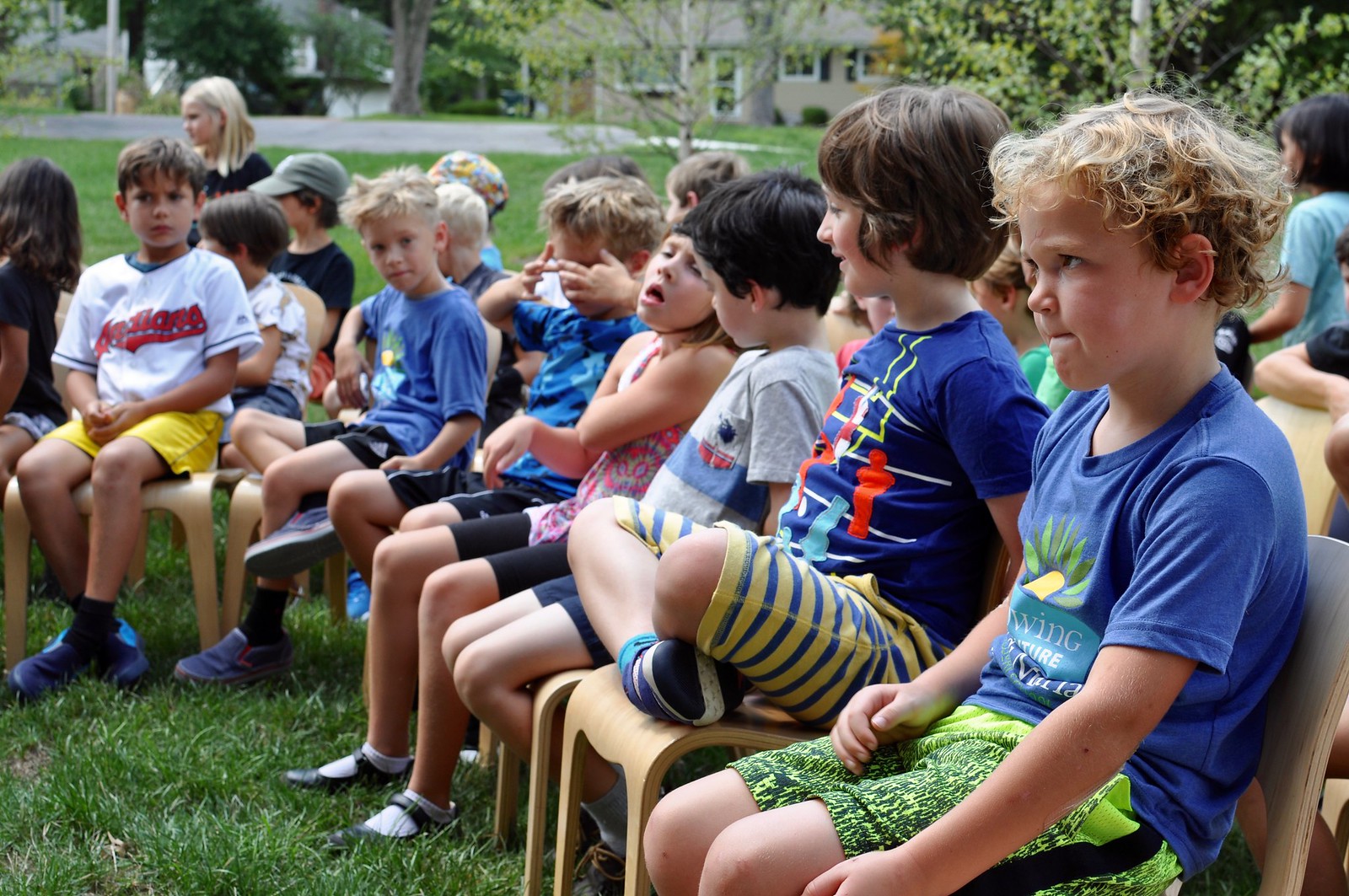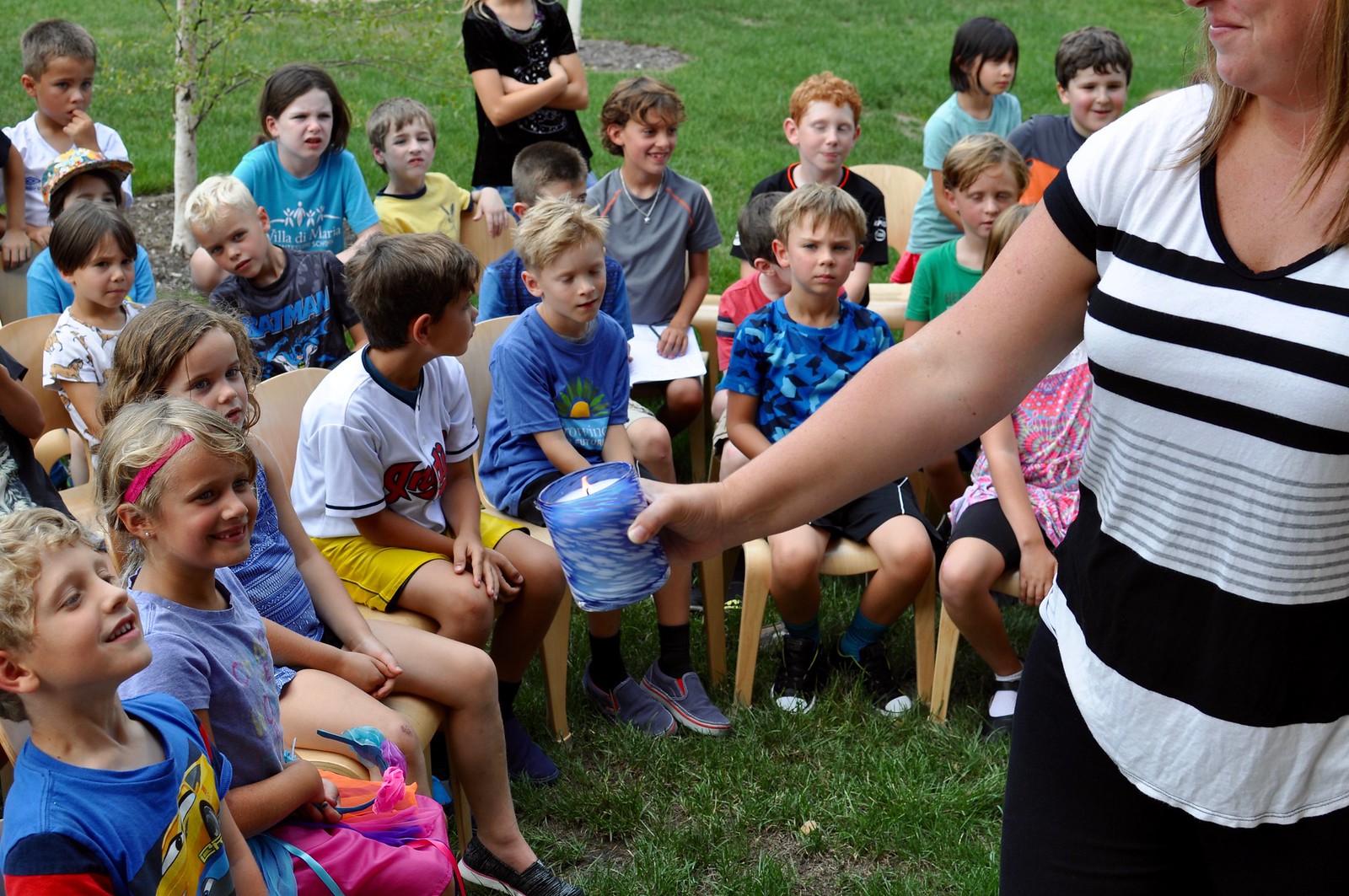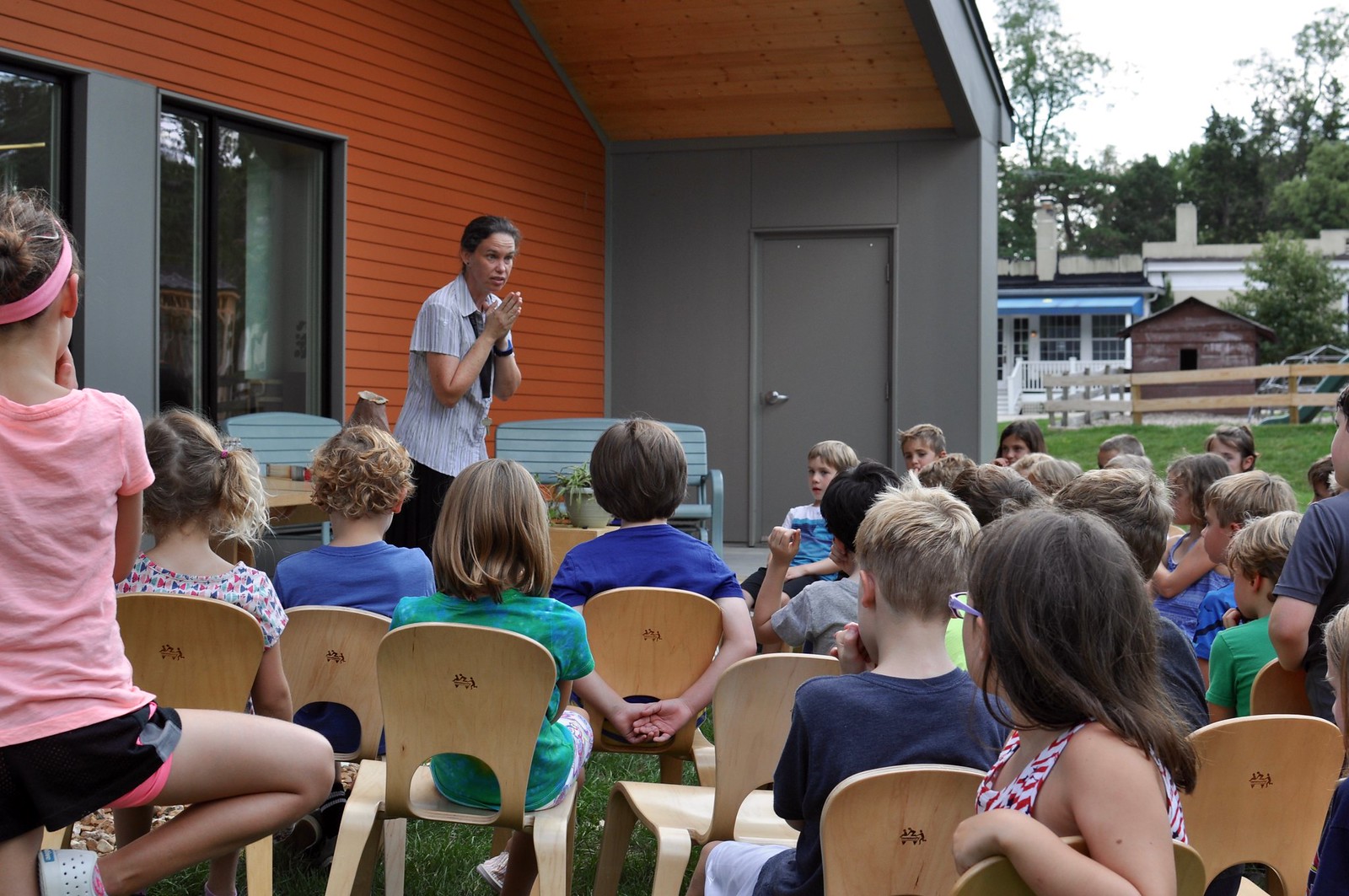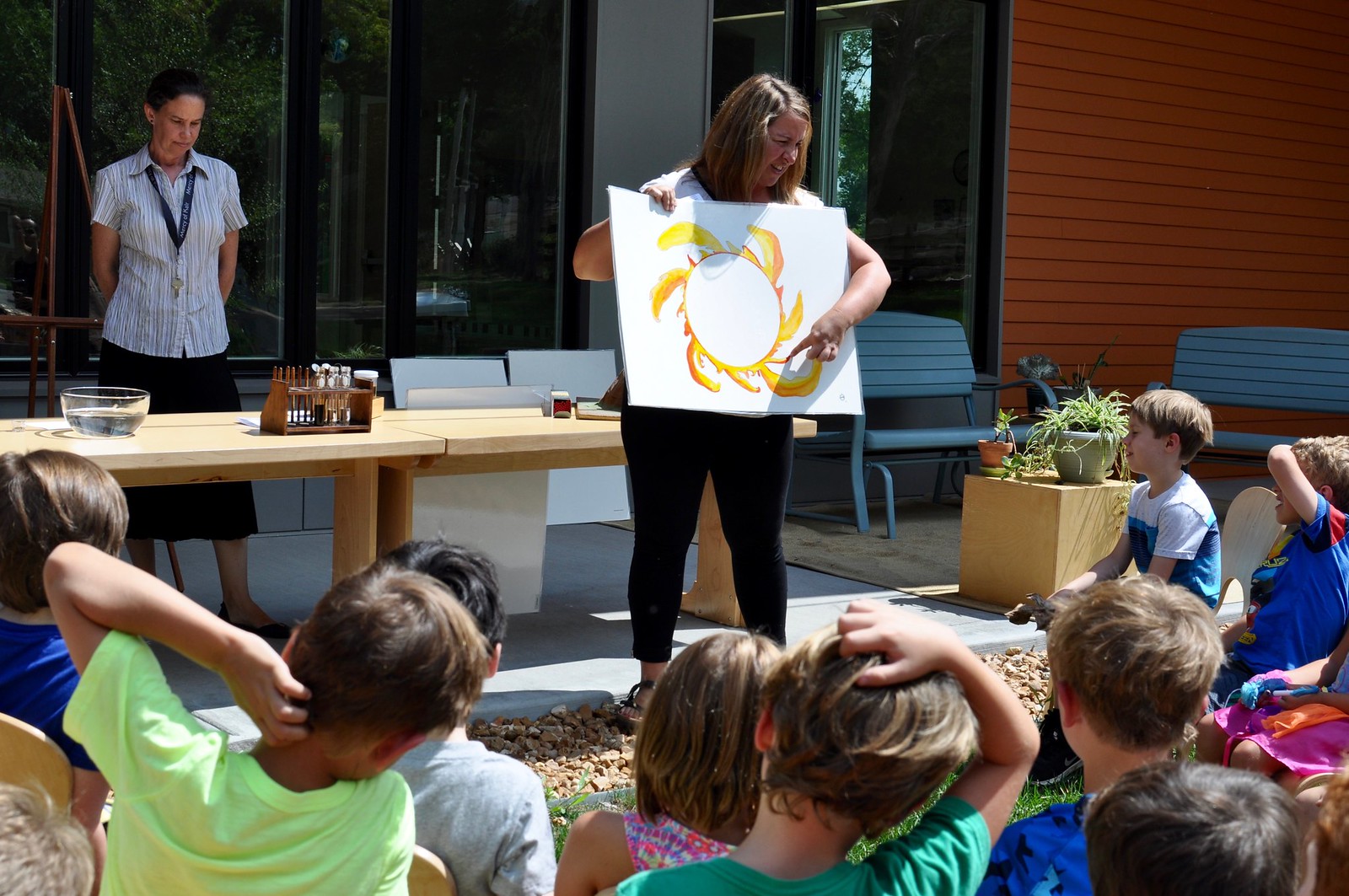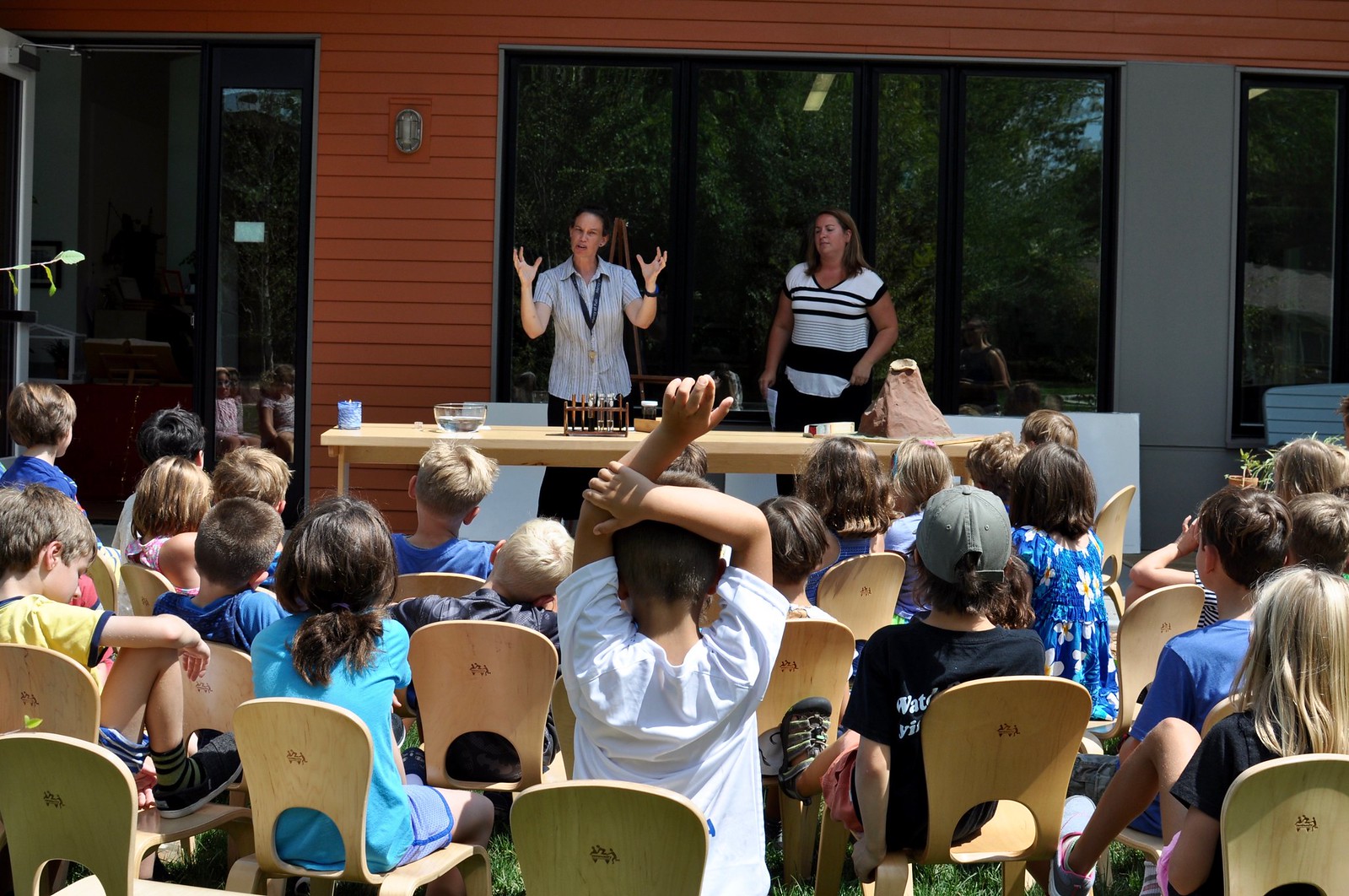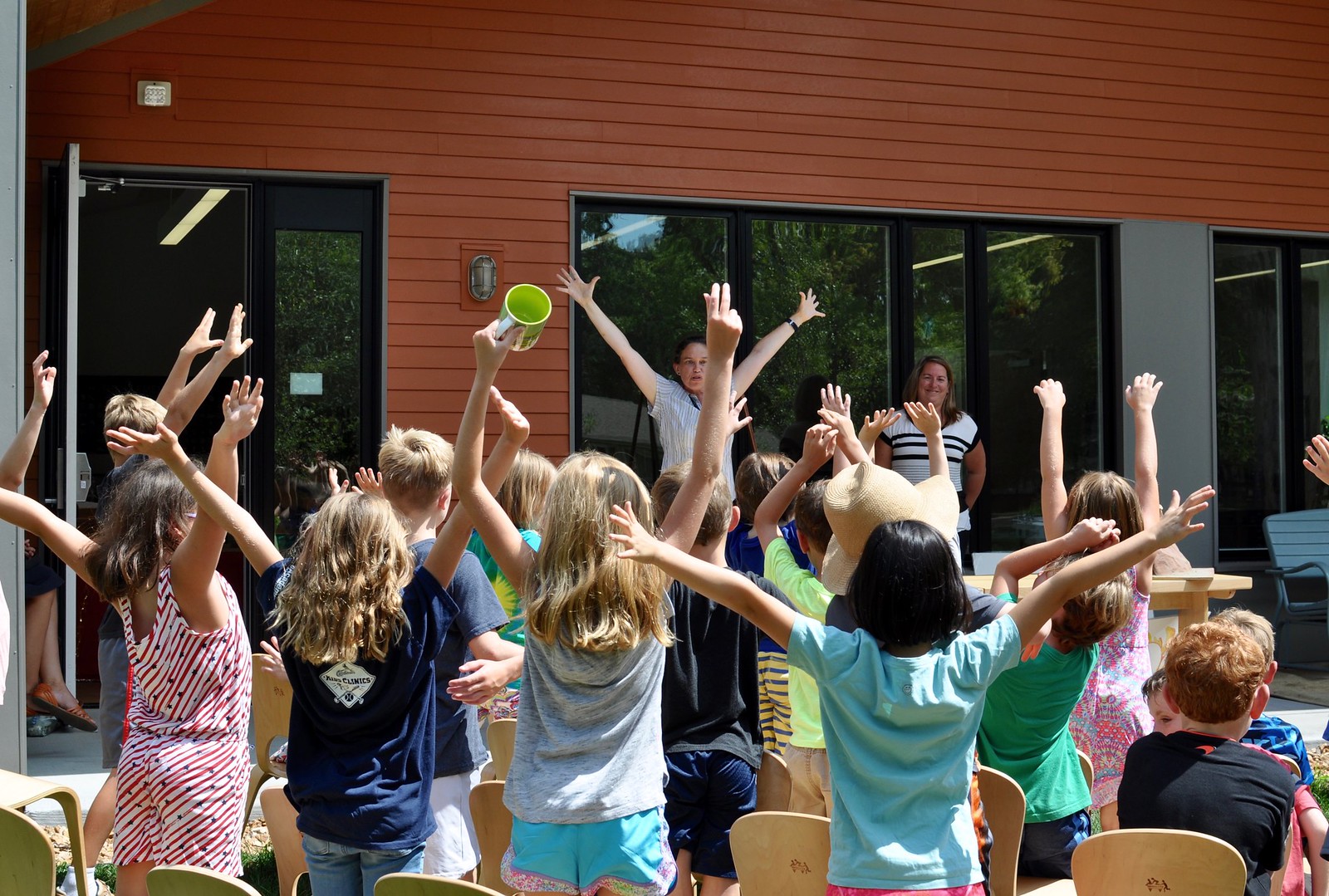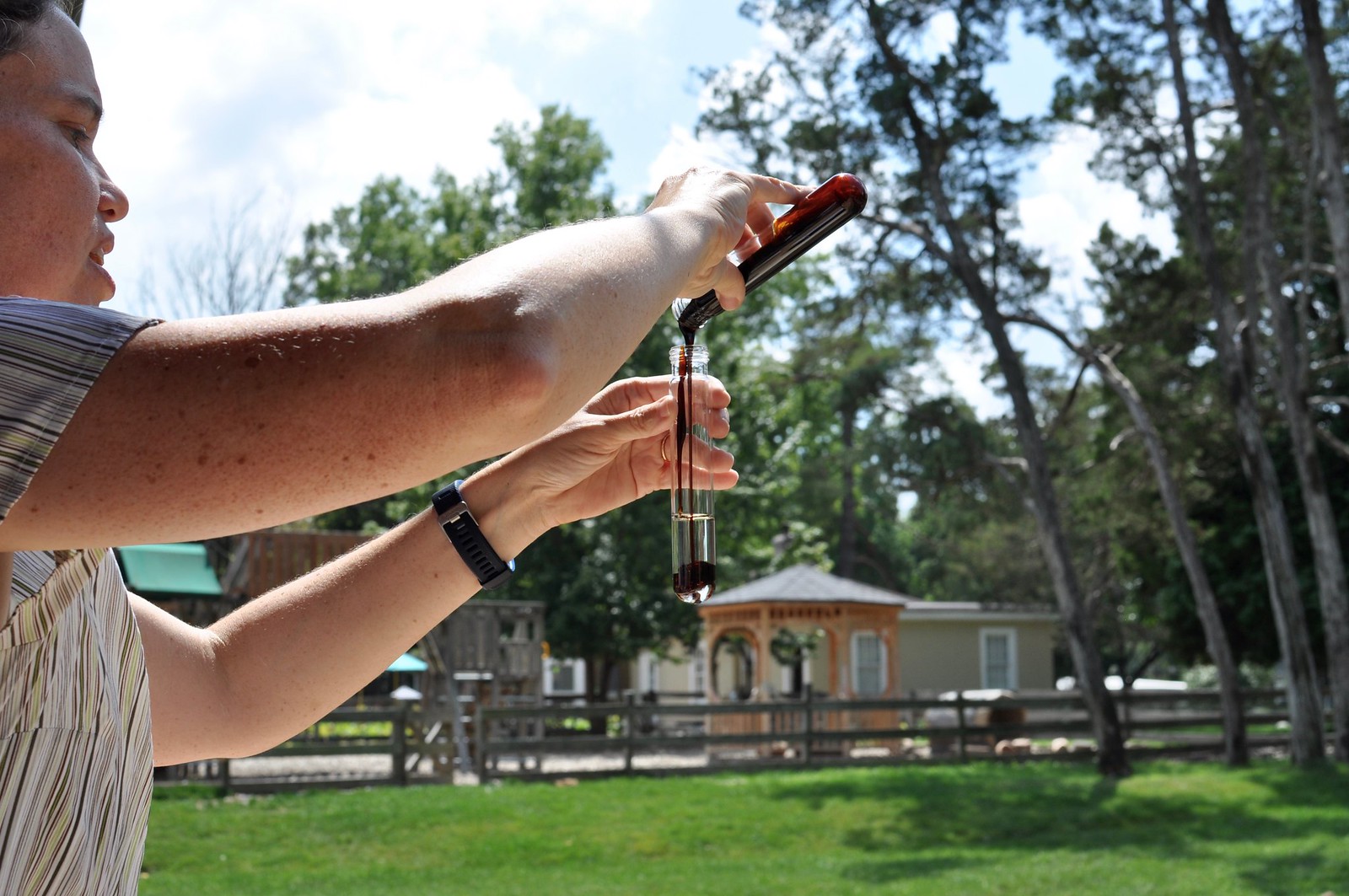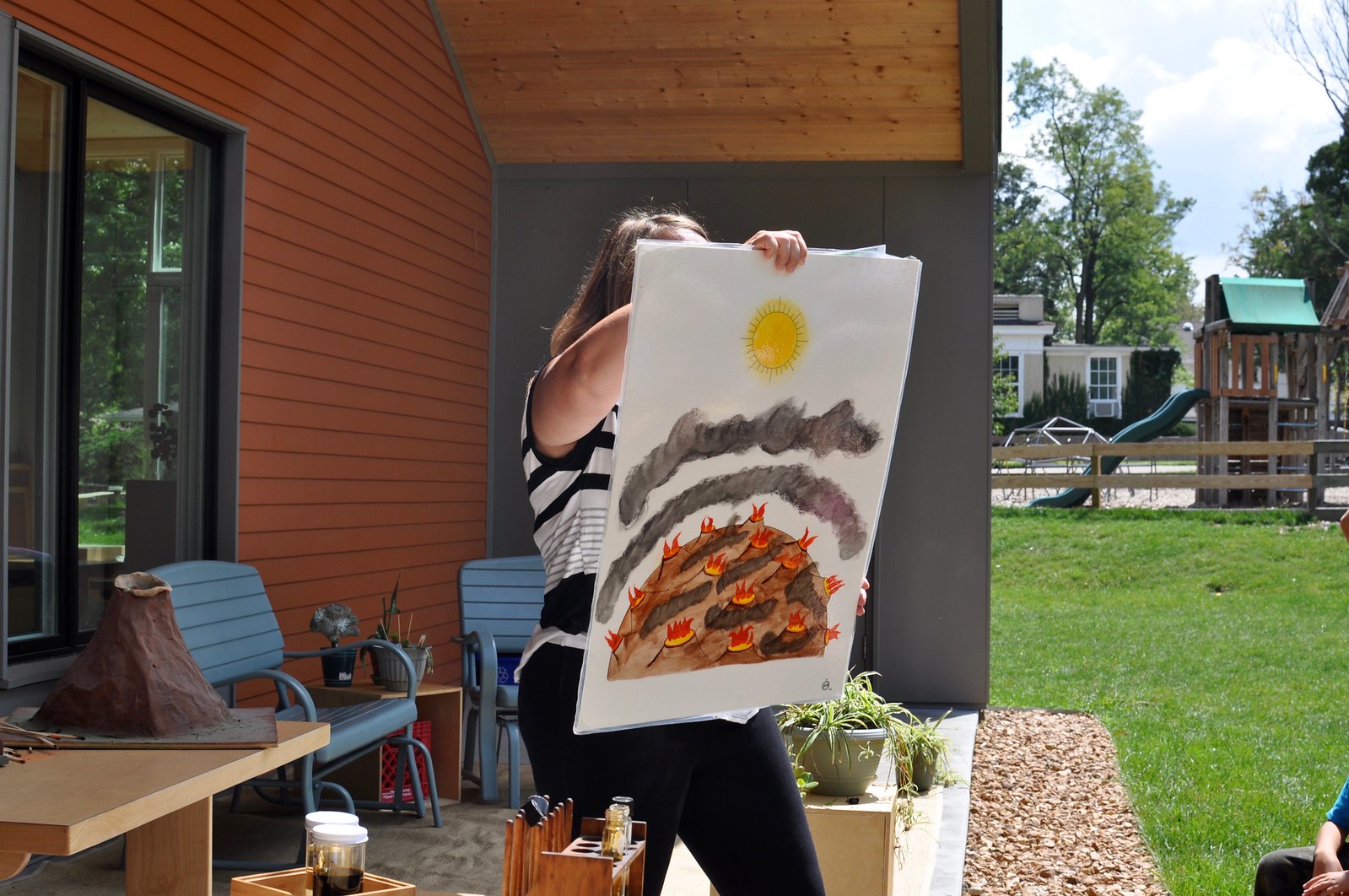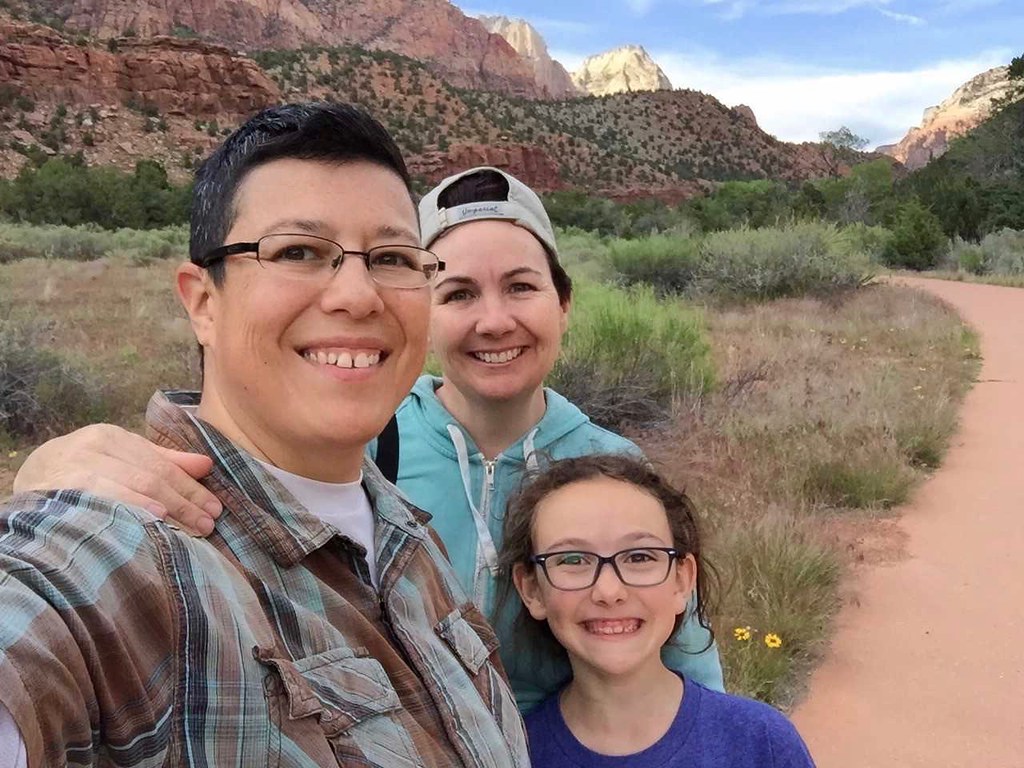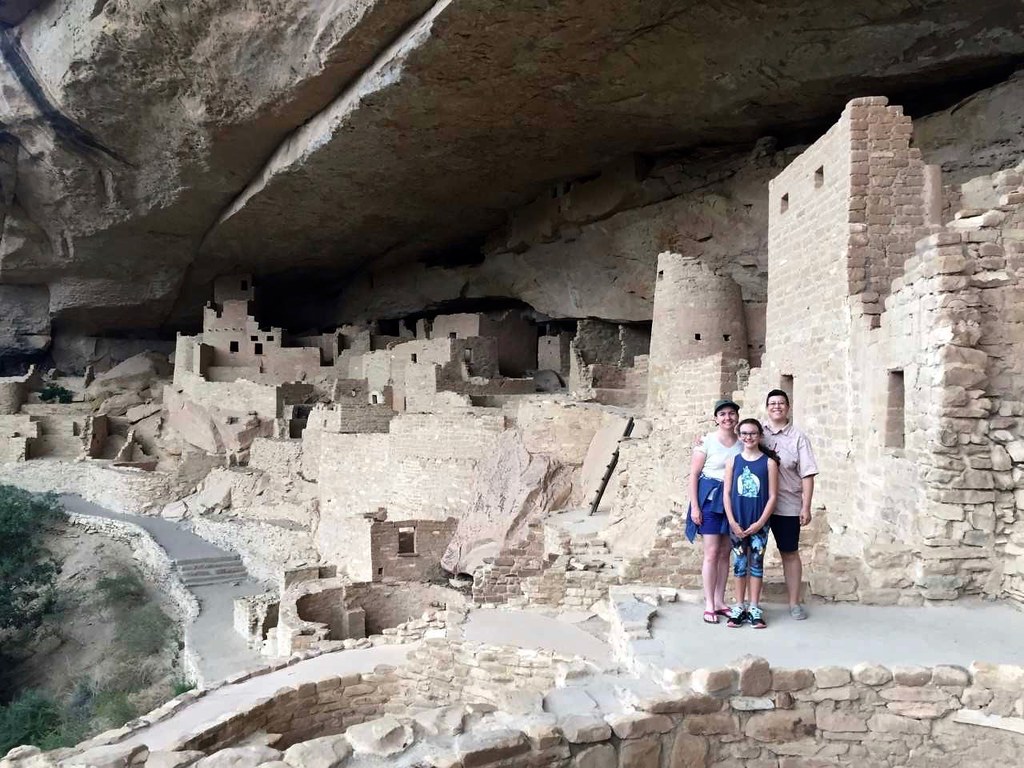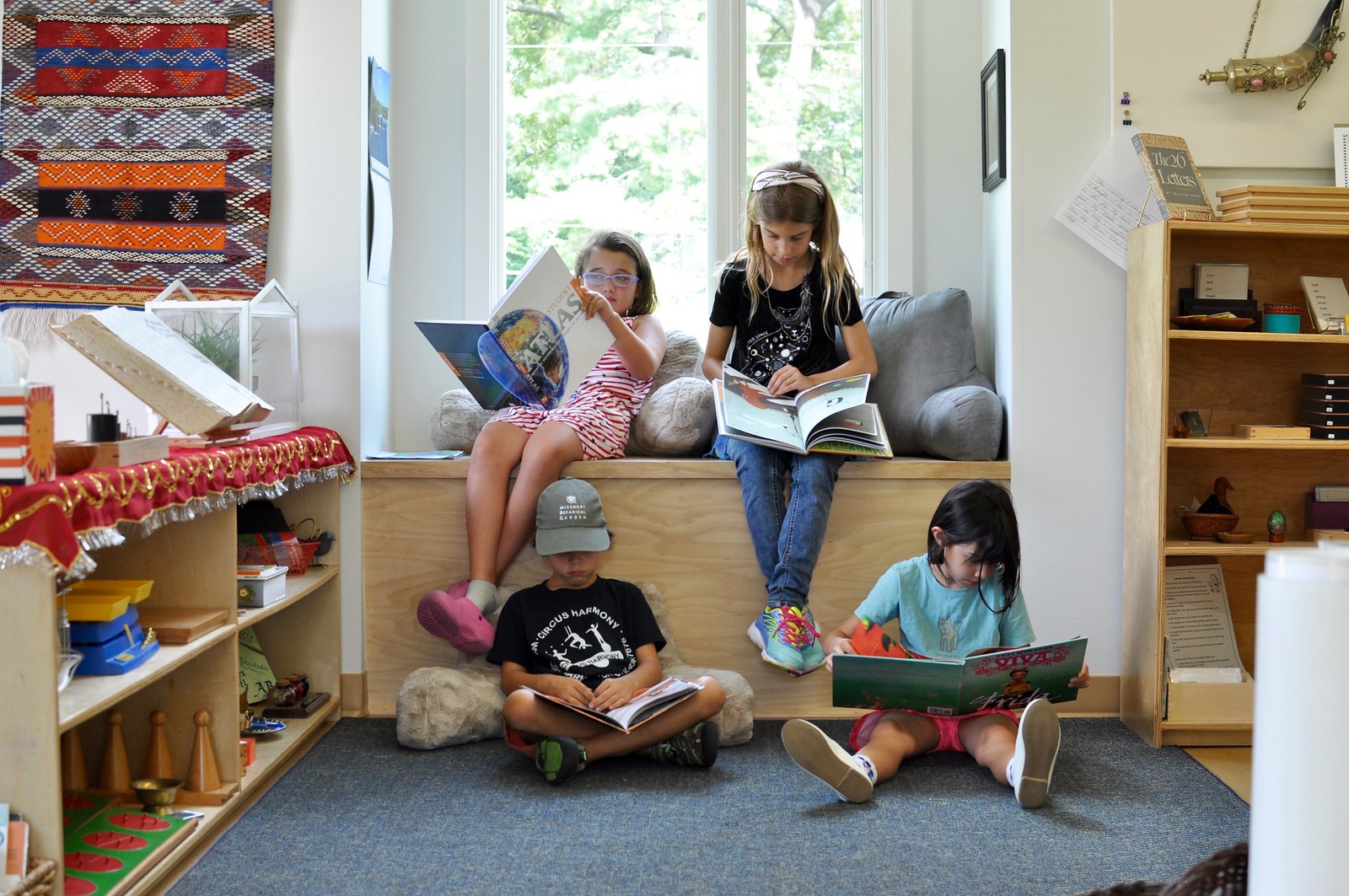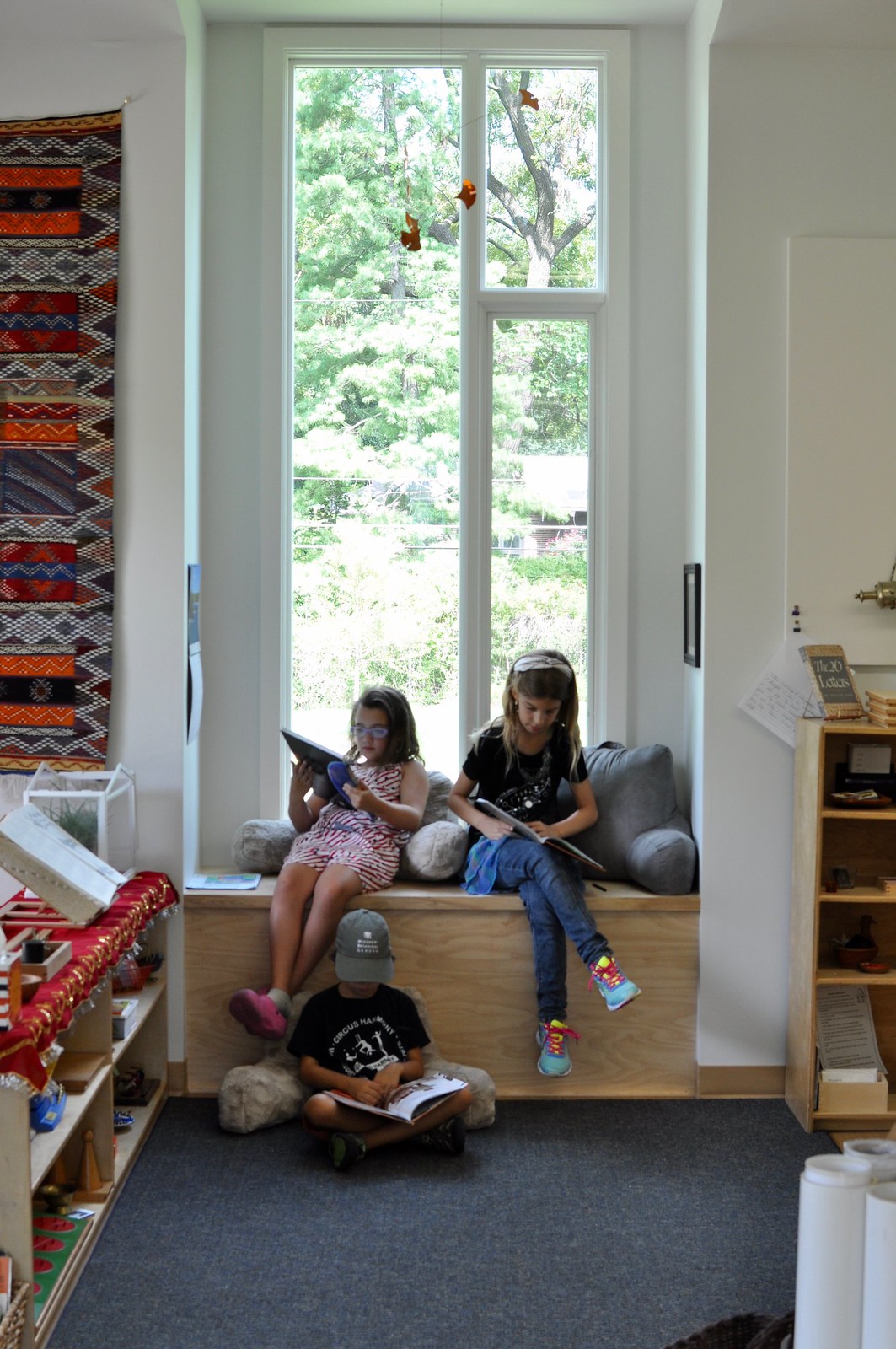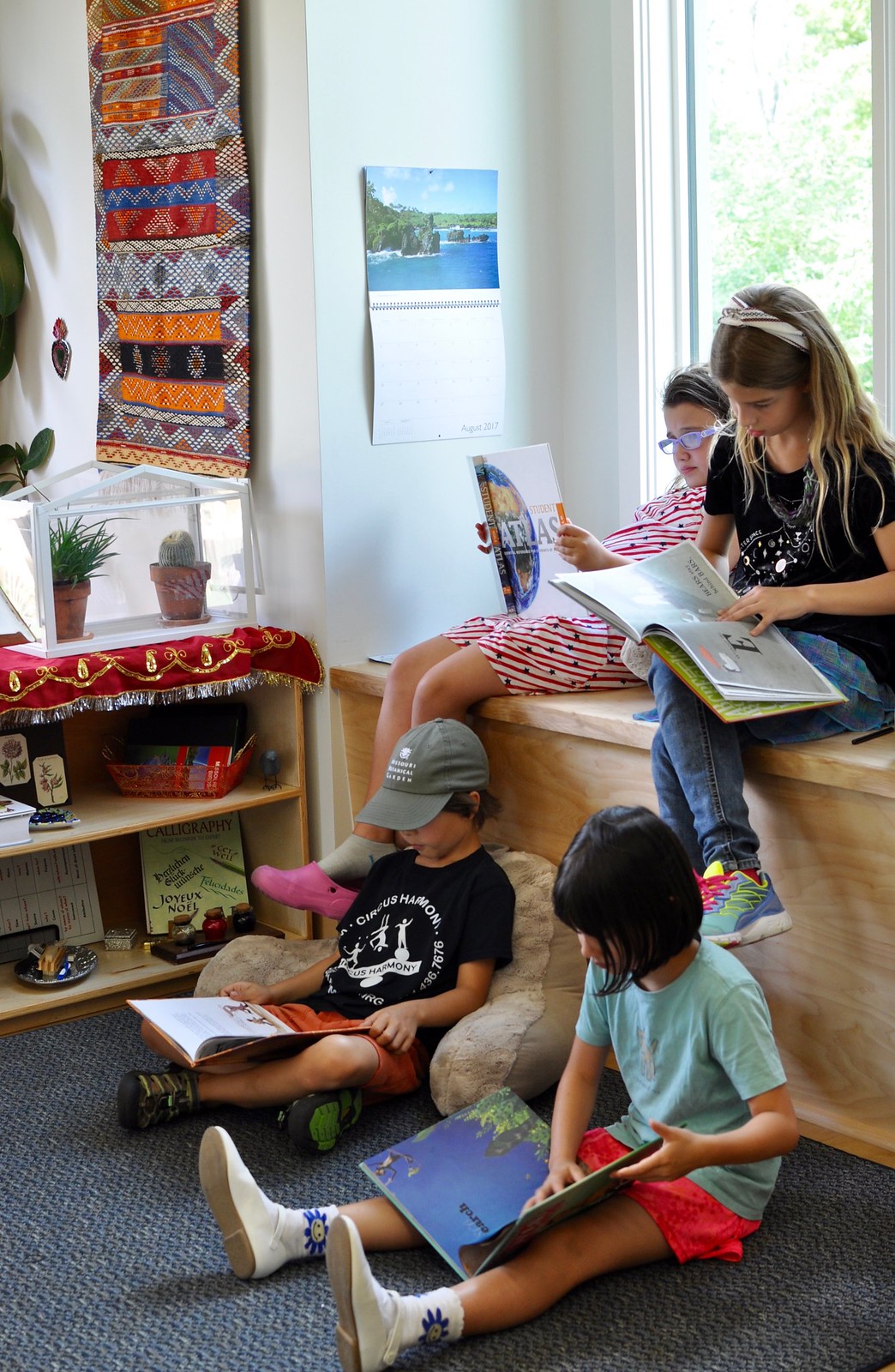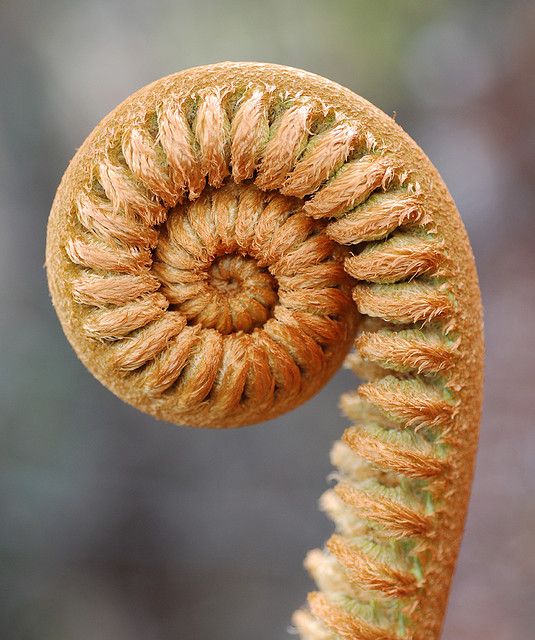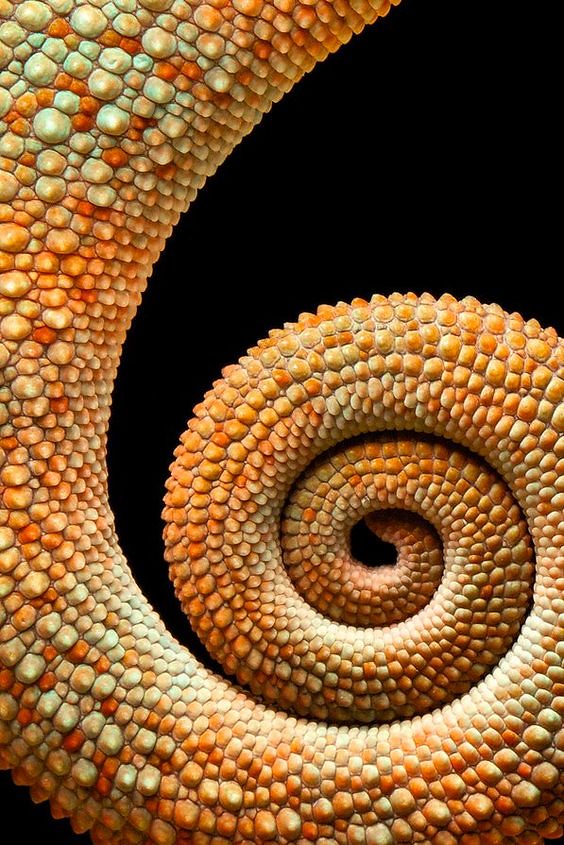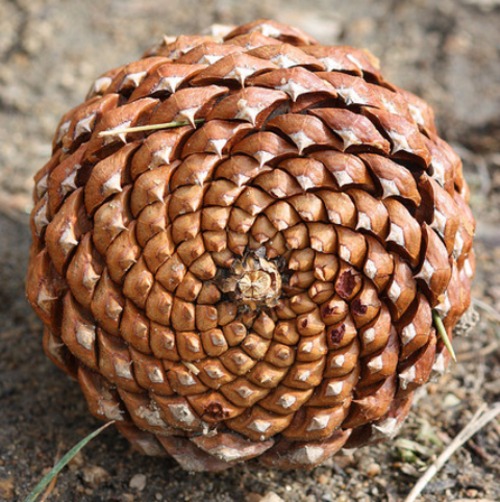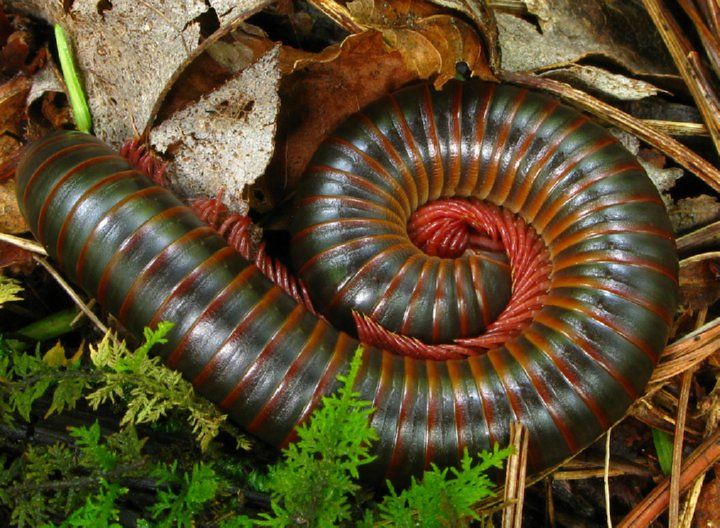
Robyn Milos, former student, Primary Directress, and Director of Education at Villa di Maria (which she has consistently called "The Best Place on Earth"), is moving on to a leadership role as Executive Director at the Montessori Training Center of St. Louis, where the first AMI Elementary Montessori Teacher training course in St. Louis will be enhanced by an Elementary Lab School starting in the fall of 2018. While we are all sad to see Robyn go, she will still occasionally be seen around campus; her youngest son, Ollie, still attends VdM. Robyn will also be adding a tremendous amount to the community through her attendance on the Board of Trustees at VdM. Her last 15 years at Villa have been significant; in putting together this post, I encountered an outpouring of love and respect from her colleagues, friends, and all those who know and love her (and there are
many - too many to represent in one blog post!)... but here is my humble attempt.
To say that Robyn has largely made Villa di Maria what it is today would be a vast understatement. From the relationships she has built through patience, trust, graciousness, and gentle words with countless children, parents, and staff, to her nudging our very own Head of School to take the position she currently holds, Robyn has been there, sometimes in the background, but always there, through thick and thin, to move us all forward.

Below, Head of School Laura Ceretti-Michelman's touching and vulnerable account of her family's strong relationship with Robyn over the years:
"Ben Michelman entered Robyn's Children's House when he was 3.2 years old. We welcomed Natalie to our family in September 2008 and in January 2009, Ben shook Robyn's hand for the first of many times. It didn't take long for the Michelman family to become raving Robyn Milos fans. Of course, Robyn had her sights on our baby and always took the time to 'chat' with Natalie to get her ready for the big day when she would join P2.
Robyn was patient with me as a parent as she watched me do all the wrong things. I carried my son, a child who was very capable of walking, to and from the classroom. I carried his things for him. If I saw him struggling to accomplish a task, I swooped in and said "Oh Ben, that is too hard, let me help." I am not proud of these things but Robyn never once called me out, she didn't judge. Instead, she kindly helped me understand fundamental Montessori tenets and then she would wait and see if the message really sunk in. Would I change my actions? And of course, with her very subtle coaching, I did.
Robyn is the reason I work at Villa di Maria. When the Head of School position became available, Robyn reached out to me immediately. When I answered the phone she said, 'Are you thinking what I am thinking?' I had no idea what she was thinking. When she shared what she was thinking - that a new training session would be starting in St. Louis that summer, that I had business experience, that I loved the school and that I should apply for the position - I nearly choked.
I was an in-house attorney for a local company. The thought of applying for the position had not crossed my mind. However, after Robyn planted the seed, I couldn't stop thinking about serving Villa di Maria. I was energized and excited and with great audacity, I applied for the position. I wasn't exactly a traditional candidate for the position and by the time the board called me for an interview, I was stunned because I was certain that they had written me off. But Robyn was always in the background encouraging me. Eventually, the board offered me the job and Robyn, who intuitively knows what to do in almost any situation, started talking about Montessori to me all the time. And thank goodness she did because I had to give a tour before my training started and I am pretty sure I used every single word Robyn ever said to me during that tour (you can ask Ruth Reese... she was my first tour).
Robyn has seen Villa through ups and downs and her devotion to the children, the school, and Montessori is immeasurable and knows no limit. Robyn is a humble learner with deep intelligence and a very open mind. She thinks, she thinks, and then she thinks some more, and she always brings a valuable perspective to the conversation. She has more common sense than most people, and she has enough positive energy to overcome a sea of pessimists. She really makes everything better. Her work ethic is unparalleled as is her integrity. Robyn has been a great asset to Villa di Maria (and will continue to be as a board member) and she has been a great friend (and will continue to be).
I will miss Robyn because, for me, she has been and is Villa di Maria (which in her words is the greatest place on Earth). I am grateful for her dedication to Pearl's pearls - VdM and The Montessori Training Center of St. Louis. Robyn is the perfect steward of Pearl's and Dr. Annette Haines' legacies. I am also just generally grateful for Robyn."

Indeed, many staff at Villa di Maria have expressed their love for Robyn and her true Montessori spirit. Below, Anna Schwind, Lower Elementary Directress, shares her memories:
"I have never met any given person who so thoroughly embodies the spirit of Maria Montessori as Robyn Milos. She not only has vast intellectual understanding of Montessori, is not only thoroughly steeped in the pedagogy, but she also has a remarkable inherent intuition for the method and for the best thing to do with each child. She gets it on an internal level that I have rarely encountered and so deeply admire. She is a gift and inspiration to the Montessori community. I feel, as the cliché often goes, blessed to know her. There are all sorts of reasons that people do a given work, and I do not necessarily believe that the work of the moment or of convenience is innately inferior to work carried out by calling or vocation, but Robyn absolutely makes manifest the importance of work undertaken as one's cosmic task.
Her loyalty and dedication to Villa have also been unsurpassed in my experience. It hardly seems possible that she is leaving us, so steadfast and consistent a present has she been for so long. I am grateful for this evolution of her, because I think she has the skillset and capacity to open up Montessori for more children, but it's strange unforeseen territory where Robyn is not a fixture at Villa.
She has such tremendous personal integrity and always, always proves with her actions the work of her words. Children sense this and are drawn to it.
She possesses a gentleness and compassion that are that hallmark of Montessori children come to adulthood. She so easily and empathetically hears others, their point of view, the difficulties they are having and offers solutions in such a low key and non-threatening way. She has a gift for constructive criticism. She understands that we work collaboratively to solve problems, even the ones in our own self.
On one occasion, I was just feeling my way to teaching Spanish at Villa, in both primary and elementary environments, a couple of times a week. I had taken stock of the materials, and I set out to make a set of three part cards for colors in Spanish. I will freely admit I had no idea what I was doing, but I can follow a model and there's no shortage of three part cards in a Montessori environment to use as a guide. Once I had made them and showed them to Robyn, she asked me if I would like to know how they are used in the environment. I jumped at the chance. We sat down with a rug and she gave me a lesson on three-part cards. My first Montessori lesson, my very own mini-Silent Journey. I understood in that moment what it would have been like to be a child in this Children's House, getting a lesson from Robyn, stepping into my own experience of learning. I was hooked. It would take me a long time to come around to getting my training and to begin teaching, but she certainly opened the way, as she does: inviting, encouraging but without pressure, knowing that all things unfold in their own time."

Cristina Kerr sends Robyn this sweet, heartfelt message:
"The two years I got to be your assistant in P2 flew by very fast...too fast I dare to say. Now that you started your new journey, you will continue to influence and guide so many more people. You were meant for this and I wish you all the luck!"
From Upper Elementary Guide Rebecca Callander:
"To me, Robyn has personified the heart of Montessori. I will never forget how full of life and love her classroom environment felt when I cared for the classroom hermit crabs over winter break my first year at Villa. The environment was so well prepared!
Robyn's incredible patience and ability to always find the right words at the right time has been inspirational. Her dedication to Montessori and to Villa di Maria, whether it be through her lengthy tenure as a directress, through her lengthy daily commute -how many miles of travel, how many inches of rubber laid upon the highway - or her countless hours as an assistant to Dr. Haines at the Montessori Training Center St. Louis, set the high mark for everyone and will be a part of our school's legacy!"

From Primary Directress Reghan McAuley:"Robyn Milos is my touchstone. She is the original source of inspiration which lead me to take the Montessori journey both spiritually and professionally. Robyn has been and will continue to be a highly respected mentor as I develop and grow in Montessori. As always, I know she is reliably only a phone call away to dig in deep or bounce around Montessori Theory. Robyn’s clarity and passion for the natural development of all young human beings is undoubtedly a gift to all. From one Primary Directress to another, I’d selfishly really like to say, “That’s not the job I was thinking of.”As I feel Robyn leaves a hole at Villa that saddens me, I know in my heart she remains a strong and important presence in the community that is linked by the greater Montessori community of Saint Louis, her family, her children and even her first grandchild. Today, Robyn is in the position to lead the Montessori Training Center of Saint Louis into a new journey as well. The power of her passion will certainly make MTC of STL a leader in the worldwide Montessori community. I have no doubt that Dr. Haines would be so incredibly proud. With that I’d like to say congratulations to my dear friend Robyn Milos and always remember: 'Ride the horse in the direction it is going.' (-Ginni Sackett)"P2 Directress Jessie Braud also had much to contribute:"I have only known her for three years, but it is nigh impossible to express in words my admiration for Robyn... she is one of my greatest role models and most influential mentors I’ve ever had. From being one of my many guides throughout my summers of Montessori training under Dr. Haines, to being my trusty training wheels throughout my first year as a directress, she has been there for me, not just as a mentor but as a friend. And perhaps she will find this as hilarious as I do, but as a marker of how her greatly her wisdom has had an impact on me, her voice is one of my Montessori 'voices in my head.' Sounds crazy, but it’s true!Honestly, her impact has been so great on my life, I wouldn’t be here today if not for her: she was the person that brought me to Villa di Maria! After my first choice in student teaching fell through, I asked (...maybe I begged?) her if she would be so kind as to take yet another trainee under her wing, and luckily she said yes! It was just a few weeks of watching her with the children, of asking her any and all questions, and of being in the Best Place on Earth, but I fell in love with Villa fast... I’ll never forget the ache when leaving, thinking that I would never come back - who in their right mind could ever leave such a wonderful place?! As such, it was one of the greatest surprises and honors of my life when Robyn asked me to take over her classroom. Her support throughout my first year was... immeasurable! And while she may not be with us as she was before, and while her hands are so very busy directly impacting so many amazing things beyond our school now, I feel deeply that her support of me, of my work, and of my Montessori journey is unshakeable - a wondrous thing, truly.It is hard not to be reminded of her absence, especially when I am spending each day in the place she loved the very most. Her heart will always, always be in our Children’s House, but it is so reassuring to know that the legacies of Dr. Haines, of Mrs. Vanderwall, and of Dr. Montessori will live on so loudly and proudly through Robyn’s work at MTC. There is truly no better person to tackle such an awesome, amazing thing! Mine is but one life of the hundreds that have been changed because of Robyn’s passion and dedication to Montessori. I am forever thankful." A heartfelt message that goes way back: Lower Elementary Directress Megan Eilers:"I can't recall when I first met Robyn, but for as long as I have been working at the camp and school, she has always been a part of Villa di Maria life. Robyn and I share the unique experience of having both attended and taught at VdM, so in many ways we have bonded over the fact that VdM is like a second home to us both. We care deeply about the school and the children, but it was Robyn who really opened my eyes to becoming an educator in a Montessori classroom.While I was in grad school, pursuing a degree in traditional education, I was required to observe in a variety of educational settings. Naturally, I picked VdM and Robyn welcomed me in to observe her classroom. Although the classroom, materials, and lessons were all familiar to me, it was something completely different to witness the children work in Robyn's classroom. She has a sleek and seamless style of implementing and talking about Montessori in the most captivating way. Watching Robyn in a classroom is like watching an artist paint a masterpiece. She knows every paint color and every tool to use to create something beautiful. I actually dug out my observation notebook from that time and found some of the notes I wrote about Robyn and my experience in her class:'She knows every child, she anticipates every need, she knows the delicate balance of when to intervene and when to step back, she always uses clear and consistent language, her lessons are presented carefully, intentionally, and delicately, and she knows how to connect every child to meaningful work.' I always knew I was witnessing something special in her classroom and I aspired to be an educator like Robyn. As I got deeper into my studies and was developing my own personal philosophy on education, I took a job in administration at VdM and found myself constantly picking Robyn's brain for information about Montessori. Ultimately, I have Robyn to thank for persuading me to pursue Montessori education further and to become a guide. After completing my training and returning to VdM to start my first year as a teacher, I entered the year both excited and nervous. Although all new teachers are told that the first year is difficult, you truly don't know what that means until you experience if for yourself. But with Robyn as the Director of Education, I felt like I had the ultimate resource and support system behind me. With Robyn's guidance, support, and reassurance, I made it through my first year of teaching. I will be forever grateful to Robyn for being the dependable shoulder I could lean on whenever I needed help. Although Robyn is no longer officially working at VdM, she will always have a place here at her home away from home. Robyn, thank you for being my inspiration, my personal Montessori guru, my mentor, and my friend. You will do amazing things for the Montessori community!Assistant Jess Jente had this to say:"Robyn trusted me with one of her most important persons- Ollie- when I first started. I'm sure that was terrifying for her, an amazing Montessorian, to trust someone who had little experience so far in the Montessori would with her wonderful Ollie. I'm so thankful she gave me a chance because I ended up learning so much from her as a parent and a coworker. I know she's off to do great things but she will surely be missed around Villa."Lower Elementary Assistant Sophie Andre wrote this beautiful poetic tribute about who Robyn is, through and through:
A heartfelt message that goes way back: Lower Elementary Directress Megan Eilers:"I can't recall when I first met Robyn, but for as long as I have been working at the camp and school, she has always been a part of Villa di Maria life. Robyn and I share the unique experience of having both attended and taught at VdM, so in many ways we have bonded over the fact that VdM is like a second home to us both. We care deeply about the school and the children, but it was Robyn who really opened my eyes to becoming an educator in a Montessori classroom.While I was in grad school, pursuing a degree in traditional education, I was required to observe in a variety of educational settings. Naturally, I picked VdM and Robyn welcomed me in to observe her classroom. Although the classroom, materials, and lessons were all familiar to me, it was something completely different to witness the children work in Robyn's classroom. She has a sleek and seamless style of implementing and talking about Montessori in the most captivating way. Watching Robyn in a classroom is like watching an artist paint a masterpiece. She knows every paint color and every tool to use to create something beautiful. I actually dug out my observation notebook from that time and found some of the notes I wrote about Robyn and my experience in her class:'She knows every child, she anticipates every need, she knows the delicate balance of when to intervene and when to step back, she always uses clear and consistent language, her lessons are presented carefully, intentionally, and delicately, and she knows how to connect every child to meaningful work.' I always knew I was witnessing something special in her classroom and I aspired to be an educator like Robyn. As I got deeper into my studies and was developing my own personal philosophy on education, I took a job in administration at VdM and found myself constantly picking Robyn's brain for information about Montessori. Ultimately, I have Robyn to thank for persuading me to pursue Montessori education further and to become a guide. After completing my training and returning to VdM to start my first year as a teacher, I entered the year both excited and nervous. Although all new teachers are told that the first year is difficult, you truly don't know what that means until you experience if for yourself. But with Robyn as the Director of Education, I felt like I had the ultimate resource and support system behind me. With Robyn's guidance, support, and reassurance, I made it through my first year of teaching. I will be forever grateful to Robyn for being the dependable shoulder I could lean on whenever I needed help. Although Robyn is no longer officially working at VdM, she will always have a place here at her home away from home. Robyn, thank you for being my inspiration, my personal Montessori guru, my mentor, and my friend. You will do amazing things for the Montessori community!Assistant Jess Jente had this to say:"Robyn trusted me with one of her most important persons- Ollie- when I first started. I'm sure that was terrifying for her, an amazing Montessorian, to trust someone who had little experience so far in the Montessori would with her wonderful Ollie. I'm so thankful she gave me a chance because I ended up learning so much from her as a parent and a coworker. I know she's off to do great things but she will surely be missed around Villa."Lower Elementary Assistant Sophie Andre wrote this beautiful poetic tribute about who Robyn is, through and through:
Robyn is this person who is always available to listen to you and give you advice.
Robyn is this person who tells you that even if she does not have an answer she will think about it.
Robyn is this person that makes you keep thinking about your conversation, even several days after.
Robyn is this person truly happy for you when something good happens to you.
Robyn is this person who seems to deeply care about what you tell her and about your life in general.
Robyn is this person always smiling and always kind.
Robyn is this person who looks like a strong rock and a light house.
Robyn is this person we love and respect.
Robyn is this person we are going to miss every day...
...very much.
And Melinda Smith, Assistant in Lower Elementary, shares her thoughts:
"I met Robyn not first as a colleague but as a parent. Villa was recommended to me by a friend - but not just Villa, Robyn. Robyn has a very welcoming spirit, her enthusiasm to teach not just the children but also the parents won me over.
Last year, although too short of a time, we became coworkers, yearbook buddies and friends. She has been beyond supportive of my role as an assistant. I used to be terrified when she came to observe the classroom. I thought she would see through me and how unsure of myself I was, but she did nothing but build up my confidence and make me feel like I was in the right place. She encourages me even now. I only wish I had more time with her as a mentor. Thank you Robyn, for welcoming me into your first home!! The Lab School is very lucky to have you!"
And last, but certainly not least, Heather Steinman's touching tribute to her dearest friend:
I met Robyn in 2003 at the school picnic at Villa di Maria. She was going to be the new teacher in one of the primary environments and had come to meet everyone. She was so friendly, and smiley, and well... she was Robyn. The thing that caught my attention right away more than anything else was the way she spoke to my children. She spoke to them like I did, like they were people. People with real ideas and things to say even though they were "just" four and two years old. She shook their hands, she looked them in the eye and she waited for them to respond, she respected them.One year later I found myself working as the assistant in Robyn's classroom, completely clueless as to what I was supposed to do, or maybe even more importantly not do! She never really told me what to do! I mean there were some guidelines, but she gave me the respect and patience that she so beautifully gave to all of the children and she let me figure it out. Don't get me wrong, if I asked her about something specifically she would tell me the answer, or more likely help me get to the answer myself. Mostly though, she led by example and I followed. Over the next five years we worked together and she became my mentor, and even more importantly my friend. I learned more in those five years than I can possibly share but I can tell you I learned it all from Robyn. On my journey through the world of Montessori, Robyn has been a constant guide. On my journey through life in general, she has been a fierce (meant in the most positive of ways) and loyal friend. I am honored to know her, I am so proud of her, I can't wait to see what she does next.Congratulations on this new journey of yours my friend, I'll be learning and following from afar ?

Robyn, clearly you will be missed, but we all rally behind you and know you will do incredible things at the Lab School, and for the Montessori community in general. We all wish you the best of luck!
 Happy October! We have had such an eventful September, it's hard to believe it's already over. This coming month will be just as full of social gatherings, including our Elementary overnight, Open Houses, Parent Conferences, VdM's parent event: the Hoedown, and an all-time favorite, which will be back on campus: BooFest - whew! Get those calendars ready! Be sure to check your email for these main events, and enjoy the photos from our most recent family event: the family campout.
Happy October! We have had such an eventful September, it's hard to believe it's already over. This coming month will be just as full of social gatherings, including our Elementary overnight, Open Houses, Parent Conferences, VdM's parent event: the Hoedown, and an all-time favorite, which will be back on campus: BooFest - whew! Get those calendars ready! Be sure to check your email for these main events, and enjoy the photos from our most recent family event: the family campout.  Villa di Maria families enjoyed a low-key (unseasonably warm, but beautiful) evening camping out on the school grounds. The bravest families set up tents and stayed overnight, while plenty of others joined friends for campfire chats, s'mores, and dark woods exploration before heading home to sleep in their own beds.
Villa di Maria families enjoyed a low-key (unseasonably warm, but beautiful) evening camping out on the school grounds. The bravest families set up tents and stayed overnight, while plenty of others joined friends for campfire chats, s'mores, and dark woods exploration before heading home to sleep in their own beds.
 It was a great opportunity to meet some new families and some adorable little siblings!
It was a great opportunity to meet some new families and some adorable little siblings!





 The children thoroughly enjoyed running around in the dark, eating sticky treats, and learning about fire safety! Have a lovely Monday.
The children thoroughly enjoyed running around in the dark, eating sticky treats, and learning about fire safety! Have a lovely Monday.








































































































